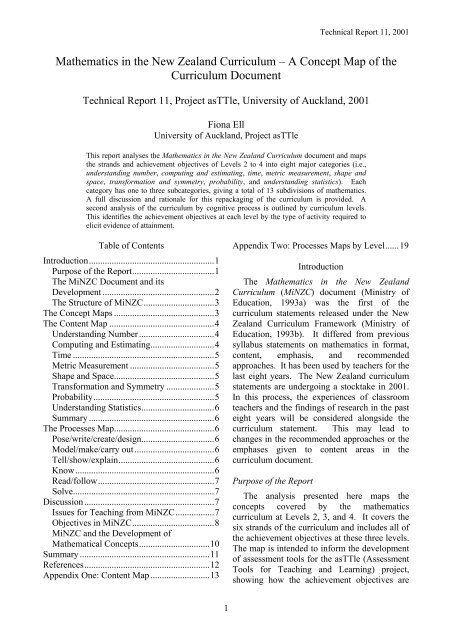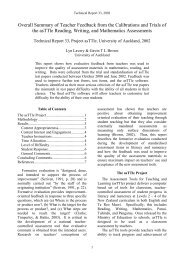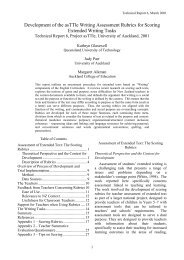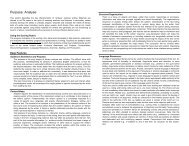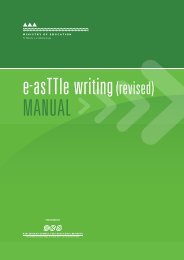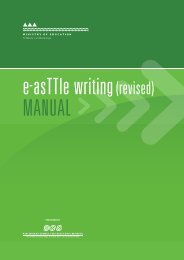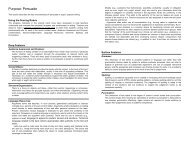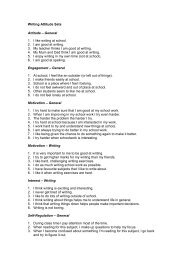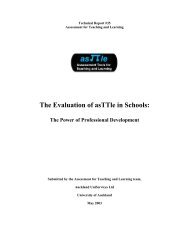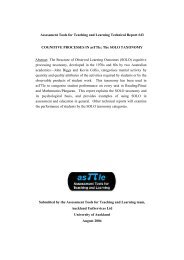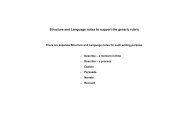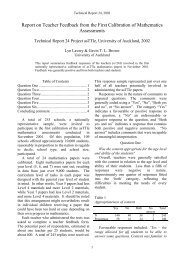11. Maths in the NZ curriculum 2001.pdf - e-asTTle - Te Kete Ipurangi
11. Maths in the NZ curriculum 2001.pdf - e-asTTle - Te Kete Ipurangi
11. Maths in the NZ curriculum 2001.pdf - e-asTTle - Te Kete Ipurangi
Create successful ePaper yourself
Turn your PDF publications into a flip-book with our unique Google optimized e-Paper software.
<strong>Te</strong>chnical Report 11, 2001<br />
Ma<strong>the</strong>matics <strong>in</strong> <strong>the</strong> New Zealand Curriculum – A Concept Map of <strong>the</strong><br />
Curriculum Document<br />
<strong>Te</strong>chnical Report 11, Project <strong>asTTle</strong>, University of Auckland, 2001<br />
Fiona Ell<br />
University of Auckland, Project <strong>asTTle</strong><br />
This report analyses <strong>the</strong> Ma<strong>the</strong>matics <strong>in</strong> <strong>the</strong> New Zealand Curriculum document and maps<br />
<strong>the</strong> strands and achievement objectives of Levels 2 to 4 <strong>in</strong>to eight major categories (i.e.,<br />
understand<strong>in</strong>g number, comput<strong>in</strong>g and estimat<strong>in</strong>g, time, metric measurement, shape and<br />
space, transformation and symmetry, probability, and understand<strong>in</strong>g statistics). Each<br />
category has one to three subcategories, giv<strong>in</strong>g a total of 13 subdivisions of ma<strong>the</strong>matics.<br />
A full discussion and rationale for this repackag<strong>in</strong>g of <strong>the</strong> <strong>curriculum</strong> is provided. A<br />
second analysis of <strong>the</strong> <strong>curriculum</strong> by cognitive process is outl<strong>in</strong>ed by <strong>curriculum</strong> levels.<br />
This identifies <strong>the</strong> achievement objectives at each level by <strong>the</strong> type of activity required to<br />
elicit evidence of atta<strong>in</strong>ment.<br />
Table of Contents<br />
Introduction.......................................................1<br />
Purpose of <strong>the</strong> Report....................................1<br />
The Mi<strong>NZ</strong>C Document and its<br />
Development .................................................2<br />
The Structure of Mi<strong>NZ</strong>C...............................3<br />
The Concept Maps ............................................3<br />
The Content Map ..............................................4<br />
Understand<strong>in</strong>g Number.................................4<br />
Comput<strong>in</strong>g and Estimat<strong>in</strong>g............................4<br />
Time ..............................................................5<br />
Metric Measurement .....................................5<br />
Shape and Space............................................5<br />
Transformation and Symmetry .....................5<br />
Probability.....................................................5<br />
Understand<strong>in</strong>g Statistics................................6<br />
Summary .......................................................6<br />
The Processes Map............................................6<br />
Pose/write/create/design................................6<br />
Model/make/carry out...................................6<br />
<strong>Te</strong>ll/show/expla<strong>in</strong>..........................................6<br />
Know.............................................................6<br />
Read/follow...................................................7<br />
Solve..............................................................7<br />
Discussion .........................................................7<br />
Issues for <strong>Te</strong>ach<strong>in</strong>g from Mi<strong>NZ</strong>C.................7<br />
Objectives <strong>in</strong> Mi<strong>NZ</strong>C....................................8<br />
Mi<strong>NZ</strong>C and <strong>the</strong> Development of<br />
Ma<strong>the</strong>matical Concepts...............................10<br />
Summary .........................................................11<br />
References.......................................................12<br />
Appendix One: Content Map ..........................13<br />
Appendix Two: Processes Maps by Level......19<br />
Introduction<br />
The Ma<strong>the</strong>matics <strong>in</strong> <strong>the</strong> New Zealand<br />
Curriculum (Mi<strong>NZ</strong>C) document (M<strong>in</strong>istry of<br />
Education, 1993a) was <strong>the</strong> first of <strong>the</strong><br />
<strong>curriculum</strong> statements released under <strong>the</strong> New<br />
Zealand Curriculum Framework (M<strong>in</strong>istry of<br />
Education, 1993b). It differed from previous<br />
syllabus statements on ma<strong>the</strong>matics <strong>in</strong> format,<br />
content, emphasis, and recommended<br />
approaches. It has been used by teachers for <strong>the</strong><br />
last eight years. The New Zealand <strong>curriculum</strong><br />
statements are undergo<strong>in</strong>g a stocktake <strong>in</strong> 2001.<br />
In this process, <strong>the</strong> experiences of classroom<br />
teachers and <strong>the</strong> f<strong>in</strong>d<strong>in</strong>gs of research <strong>in</strong> <strong>the</strong> past<br />
eight years will be considered alongside <strong>the</strong><br />
<strong>curriculum</strong> statement. This may lead to<br />
changes <strong>in</strong> <strong>the</strong> recommended approaches or <strong>the</strong><br />
emphases given to content areas <strong>in</strong> <strong>the</strong><br />
<strong>curriculum</strong> document.<br />
Purpose of <strong>the</strong> Report<br />
The analysis presented here maps <strong>the</strong><br />
concepts covered by <strong>the</strong> ma<strong>the</strong>matics<br />
<strong>curriculum</strong> at Levels 2, 3, and 4. It covers <strong>the</strong><br />
six strands of <strong>the</strong> <strong>curriculum</strong> and <strong>in</strong>cludes all of<br />
<strong>the</strong> achievement objectives at <strong>the</strong>se three levels.<br />
The map is <strong>in</strong>tended to <strong>in</strong>form <strong>the</strong> development<br />
of assessment tools for <strong>the</strong> <strong>asTTle</strong> (Assessment<br />
Tools for <strong>Te</strong>ach<strong>in</strong>g and Learn<strong>in</strong>g) project,<br />
show<strong>in</strong>g how <strong>the</strong> achievement objectives are<br />
1
2 Ell, F.<br />
l<strong>in</strong>ked and how <strong>the</strong>y reflect <strong>the</strong> development of<br />
ma<strong>the</strong>matical concepts. Two maps are<br />
presented. One divides <strong>the</strong> <strong>curriculum</strong> <strong>in</strong>to key<br />
<strong>the</strong>mes, which simplify <strong>the</strong> sub-strands<br />
identified <strong>in</strong> <strong>the</strong> document. The second focuses<br />
on processes, and presents <strong>the</strong> objectives <strong>in</strong><br />
clusters based on <strong>the</strong> ma<strong>the</strong>matical processes<br />
<strong>the</strong>y promote and <strong>the</strong> skills children develop<br />
across <strong>the</strong> strands.<br />
The Mi<strong>NZ</strong>C Document and its Development<br />
Ma<strong>the</strong>matics <strong>in</strong> <strong>the</strong> New Zealand Curriculum<br />
replaced several separate <strong>curriculum</strong> documents<br />
<strong>in</strong> ma<strong>the</strong>matics. In <strong>the</strong> primary area, two<br />
documents had existed previously – one for<br />
Years 0–6 (Department of Education, 1985) and<br />
one for Years 7–8 (Department of Education,<br />
1987). It was <strong>the</strong> first document <strong>in</strong> <strong>the</strong> revision<br />
of <strong>the</strong> New Zealand <strong>curriculum</strong> to present a<br />
“seamless” statement of objectives from school<br />
entry to <strong>the</strong> end of secondary school<strong>in</strong>g. For<br />
<strong>the</strong> first time, teachers could easily trace <strong>the</strong><br />
orig<strong>in</strong>s and consequences of ma<strong>the</strong>matical<br />
understand<strong>in</strong>gs through <strong>the</strong> levels presented <strong>in</strong><br />
<strong>the</strong> <strong>curriculum</strong>.<br />
The Education Review Office (1994), <strong>in</strong><br />
consider<strong>in</strong>g <strong>the</strong> implementation of <strong>the</strong> newly<br />
gazetted Mi<strong>NZ</strong>C document <strong>in</strong> 272 schools,<br />
listed key <strong>in</strong>fluences on <strong>the</strong> document’s<br />
development. These were current syllabi, good<br />
classroom practice, new technology, <strong>the</strong> results<br />
of <strong>the</strong> International Association for Educational<br />
Achievement (IEA) ma<strong>the</strong>matics study (1979–<br />
81) and two <strong>in</strong>fluential <strong>in</strong>ternational documents<br />
– <strong>the</strong> National Council of <strong>Te</strong>achers of<br />
Ma<strong>the</strong>matics (NCTM) Standards (1989) and<br />
Ma<strong>the</strong>matics Counts, known as <strong>the</strong> Cockcroft<br />
Report (Committee of Inquiry <strong>in</strong>to <strong>the</strong> <strong>Te</strong>ach<strong>in</strong>g<br />
of Ma<strong>the</strong>matics <strong>in</strong> Schools, 1982). These two<br />
documents, <strong>the</strong> first from <strong>the</strong> United States and<br />
<strong>the</strong> second from Great Brita<strong>in</strong>, <strong>in</strong>fluenced<br />
<strong>curriculum</strong> development <strong>in</strong> several countries.<br />
They began to articulate a constructivist<br />
approach to develop<strong>in</strong>g ma<strong>the</strong>matical concepts,<br />
based on context-bound problem solv<strong>in</strong>g and a<br />
focus on children’s ma<strong>the</strong>matical th<strong>in</strong>k<strong>in</strong>g.<br />
Alongside this were measures to order and level<br />
ma<strong>the</strong>matical concepts <strong>in</strong>to a prescription that<br />
could be followed by classroom teachers. The<br />
strand of ma<strong>the</strong>matical processes was<br />
<strong>in</strong>troduced to promote <strong>the</strong> teach<strong>in</strong>g and<br />
assessment of problem-solv<strong>in</strong>g processes and<br />
communication of ma<strong>the</strong>matical ideas. This<br />
reflected <strong>the</strong> NCTM Standards emphasis on a<br />
problem-solv<strong>in</strong>g base for <strong>the</strong> <strong>curriculum</strong>.<br />
Garden (1997) considered <strong>the</strong> results on<br />
<strong>curriculum</strong> analysis undertaken for <strong>the</strong> Third<br />
International Ma<strong>the</strong>matics and Science Study<br />
(1995). It revealed that for “...<strong>the</strong> new curricula<br />
<strong>in</strong> maths and science, New Zealand teachers<br />
were expected to cover more topics each year<br />
than were teachers <strong>in</strong> most o<strong>the</strong>r countries” (p.<br />
187). In critiqu<strong>in</strong>g <strong>the</strong> document, Howson<br />
(1994) noted that problems “...do not arise from<br />
<strong>the</strong> choice of educational aims, but ra<strong>the</strong>r from<br />
over-ambition” (p. i). Not only is <strong>the</strong> Mi<strong>NZ</strong>C<br />
document broad and full conceptually, but <strong>the</strong><br />
recommended teach<strong>in</strong>g approaches are<br />
challeng<strong>in</strong>g: “...implementation of <strong>the</strong>m <strong>in</strong> <strong>the</strong><br />
manner which is <strong>in</strong>tended demands<br />
considerable expertise <strong>in</strong> subject matter,<br />
pedagogy and assessment” (Howson, 1994, p.<br />
187). Howson (1994) considered that <strong>the</strong><br />
document conta<strong>in</strong>ed too many concepts for<br />
children to tackle, and that <strong>the</strong> constructivist<br />
approach was difficult to use well.<br />
S<strong>in</strong>ce <strong>the</strong> <strong>in</strong>troduction of Mi<strong>NZ</strong>C, <strong>the</strong><br />
M<strong>in</strong>istry of Education has provided <strong>in</strong>service<br />
support, through <strong>the</strong> <strong>Te</strong>achers or Schools<br />
Support Services Advisory and Colleges of<br />
Education (ERO, 1994). The Ma<strong>the</strong>matics and<br />
Science Taskforce recommended that <strong>the</strong><br />
M<strong>in</strong>istry provide additional support and<br />
materials for teachers. Subsequently, <strong>the</strong><br />
M<strong>in</strong>istry has published guides to problem<br />
solv<strong>in</strong>g (Holton & Thomas, 1999), to <strong>the</strong><br />
development bands for better students (M<strong>in</strong>istry<br />
of Education, 1996), and to develop<strong>in</strong>g<br />
ma<strong>the</strong>matics programmes (M<strong>in</strong>istry of<br />
Education, 1997). They have provided booklets<br />
for teachers (Figure it Out and Connected), and<br />
<strong>the</strong>re are Internet resources available through<br />
<strong>Te</strong> <strong>Kete</strong> <strong>Ipurangi</strong> (www.tki.org.nz) and ‘<strong>NZ</strong><br />
<strong>Maths</strong>’ (www.nzmaths.co.nz) sites.<br />
The work of several review groups has<br />
<strong>in</strong>creased recognition of <strong>the</strong> importance of <strong>the</strong><br />
number strand, particularly at Levels 1 to 3.<br />
Update 45 (M<strong>in</strong>istry of Education, February<br />
2001) outl<strong>in</strong>es <strong>the</strong> development of frameworks<br />
for understand<strong>in</strong>g children’s number concepts.
<strong>Te</strong>chnical Report 11: Mapp<strong>in</strong>g <strong>the</strong> Ma<strong>the</strong>matics Curriculum 3<br />
This work is supported by professional<br />
development for teachers, and aims to <strong>in</strong>crease<br />
<strong>the</strong> emphasis given to develop<strong>in</strong>g number sense<br />
and computation by promot<strong>in</strong>g mental strategies<br />
and understand<strong>in</strong>g <strong>the</strong>ir emergence.<br />
The Mi<strong>NZ</strong>C statement has directed teachers<br />
to a new way of teach<strong>in</strong>g ma<strong>the</strong>matics. Over<br />
<strong>the</strong> eight years s<strong>in</strong>ce its <strong>in</strong>troduction, it has<br />
become a familiar document to classroom<br />
teachers. Resources and professional<br />
development have been provided to support its<br />
implementation <strong>in</strong> schools. Its effectiveness <strong>in</strong><br />
practice is be<strong>in</strong>g currently considered <strong>in</strong> <strong>the</strong><br />
<strong>curriculum</strong> stocktake process.<br />
The Structure of Mi<strong>NZ</strong>C<br />
The National Education Guidel<strong>in</strong>es<br />
(M<strong>in</strong>istry of Education, 2000), The New<br />
Zealand Curriculum Framework (M<strong>in</strong>istry of<br />
Education, 1993b), and <strong>the</strong> Mi<strong>NZ</strong>C document<br />
all state clearly <strong>the</strong> importance of ma<strong>the</strong>matical<br />
literacy for daily life and <strong>in</strong> <strong>the</strong> world of work.<br />
Ma<strong>the</strong>matics is considered essential to<br />
function<strong>in</strong>g well <strong>in</strong> society, as it contributes to<br />
many daily activities (M<strong>in</strong>istry of Education,<br />
1993b, p. 11). Ma<strong>the</strong>matics taught <strong>in</strong><br />
classrooms should reflect this by us<strong>in</strong>g contextbased,<br />
real-life problems, accord<strong>in</strong>g to <strong>the</strong><br />
<strong>curriculum</strong>. Sense-mak<strong>in</strong>g and effective<br />
problem solv<strong>in</strong>g are key aims.<br />
Ma<strong>the</strong>matics <strong>in</strong> <strong>the</strong> New Zealand Curriculum<br />
divides ma<strong>the</strong>matics <strong>in</strong>to five content strands<br />
and one processes strand. The content strands<br />
are number, geometry, measurement, algebra<br />
and statistics, and probability. The sixth strand<br />
is ma<strong>the</strong>matical processes. This strand <strong>in</strong>cludes<br />
<strong>the</strong> sub-strands of problem solv<strong>in</strong>g,<br />
communicat<strong>in</strong>g ma<strong>the</strong>matical ideas, and logic<br />
and reason<strong>in</strong>g, and is where th<strong>in</strong>k<strong>in</strong>g and<br />
work<strong>in</strong>g “like a ma<strong>the</strong>matician” is taught. This<br />
strand is taught as an <strong>in</strong>tegral part of <strong>the</strong> content<br />
strands.<br />
Each strand has eight levels, except Number<br />
which has six. Each level is designed to cover<br />
two years of school<strong>in</strong>g, although <strong>the</strong> document<br />
shows that children at a given Year may be<br />
work<strong>in</strong>g at a number of levels (Mi<strong>NZ</strong>C,<br />
M<strong>in</strong>istry of Education, 1993a, p. 17). The<br />
strands are each divided <strong>in</strong>to sub-strands, and<br />
objectives are established for each of <strong>the</strong>se substrands.<br />
Examples of learn<strong>in</strong>g activities are<br />
given on <strong>the</strong> pages fac<strong>in</strong>g <strong>the</strong> objectives, and<br />
<strong>the</strong>re are also suggestions for assessment and<br />
extend<strong>in</strong>g children at each level. The objectives<br />
all beg<strong>in</strong> with “with<strong>in</strong> a range of mean<strong>in</strong>gful<br />
contexts, children should be able to...”, referr<strong>in</strong>g<br />
to <strong>the</strong> importance of sense-mak<strong>in</strong>g and<br />
relevance <strong>in</strong> design<strong>in</strong>g ma<strong>the</strong>matics tasks.<br />
The Concept Maps<br />
Two concept maps are presented <strong>in</strong> this<br />
report. A concept map attempts to show<br />
graphically <strong>the</strong> development of ma<strong>the</strong>matical<br />
understand<strong>in</strong>g as it is outl<strong>in</strong>ed by <strong>the</strong> <strong>curriculum</strong><br />
document. These maps do not go beyond <strong>the</strong><br />
<strong>curriculum</strong> <strong>in</strong>to <strong>the</strong> concepts implied by <strong>the</strong><br />
objectives. They order and l<strong>in</strong>k <strong>the</strong> descriptions<br />
given <strong>in</strong> <strong>the</strong> <strong>curriculum</strong> document. At each<br />
level, <strong>the</strong> Mi<strong>NZ</strong>C document provides objectives<br />
that can be clearly l<strong>in</strong>ked to those at <strong>the</strong> next<br />
level. While <strong>the</strong>y vary widely <strong>in</strong> specificity, <strong>the</strong><br />
objectives follow one ano<strong>the</strong>r logically. The<br />
achievement objectives are widely used by<br />
teachers as <strong>the</strong> basis for daily as well as unit<br />
plann<strong>in</strong>g.<br />
The first map condenses <strong>the</strong>se objectives <strong>in</strong>to<br />
an eight-part framework. This map is based on<br />
<strong>the</strong> <strong>curriculum</strong> sub-strands, ra<strong>the</strong>r than on <strong>the</strong><br />
six pr<strong>in</strong>cipal strands. The sub-strands have<br />
been condensed <strong>in</strong>to key <strong>the</strong>mes, and <strong>in</strong> some<br />
cases objectives have been moved from <strong>the</strong><br />
strand <strong>in</strong> which <strong>the</strong>y are found <strong>in</strong> <strong>the</strong><br />
<strong>curriculum</strong>. These changes are described <strong>in</strong><br />
detail below. The objectives are presented by<br />
level, show<strong>in</strong>g how <strong>the</strong>y develop from <strong>the</strong><br />
previous level. In this map, ma<strong>the</strong>matical<br />
process objectives are presumed to be taught<br />
across all eight parts of <strong>the</strong> framework, and are<br />
not listed separately.<br />
The second map reorganises <strong>the</strong> <strong>curriculum</strong><br />
objectives accord<strong>in</strong>g to <strong>the</strong> types of<br />
ma<strong>the</strong>matical activity <strong>the</strong>y imply. Each of <strong>the</strong><br />
six areas is listed with <strong>the</strong> ma<strong>the</strong>matical<br />
processes that perta<strong>in</strong> to each area preced<strong>in</strong>g <strong>the</strong><br />
content objectives. This preserves <strong>the</strong> preem<strong>in</strong>ence<br />
of process objectives, reflect<strong>in</strong>g <strong>the</strong><br />
emphasis <strong>in</strong> <strong>the</strong> <strong>curriculum</strong>.<br />
Writ<strong>in</strong>g a ma<strong>the</strong>matics <strong>curriculum</strong> requires<br />
decisions about what will be <strong>in</strong>cluded, where it<br />
will sit, and how it will be described. There are
4 Ell, F.<br />
commonalities between curricula<br />
<strong>in</strong>ternationally, but <strong>the</strong>re are many differences<br />
too. Any decisions about where content<br />
objectives “belong” must be somewhat<br />
arbitrary. Ma<strong>the</strong>matics is a tool for th<strong>in</strong>k<strong>in</strong>g, an<br />
<strong>in</strong>tegrated whole. The decisions about<br />
organis<strong>in</strong>g <strong>the</strong> maps presented here have been<br />
made with reference to classroom practice and<br />
ma<strong>the</strong>matics education literature, but are still to<br />
some extent arbitrary.<br />
The Content Map<br />
The first map collapses <strong>the</strong> <strong>curriculum</strong><br />
objectives <strong>in</strong>to eight areas – understand<strong>in</strong>g<br />
number, comput<strong>in</strong>g and estimat<strong>in</strong>g, time, metric<br />
measurement, shape and space, transformation<br />
and symmetry, probability, and understand<strong>in</strong>g<br />
statistics, each reflect<strong>in</strong>g key <strong>the</strong>mes. While<br />
some of <strong>the</strong>se areas correspond to <strong>the</strong> substrands<br />
<strong>in</strong> <strong>the</strong> <strong>curriculum</strong> document, o<strong>the</strong>rs have<br />
been broadened to <strong>in</strong>clude objectives from<br />
several strands that contribute to <strong>the</strong><br />
development of similar concepts. Each of <strong>the</strong><br />
areas is discussed below. The Content Map<br />
itself can be found <strong>in</strong> Appendix One.<br />
Understand<strong>in</strong>g Number<br />
Develop<strong>in</strong>g a number sense (McChesney &<br />
Biddulph, 1994), or understand<strong>in</strong>g of how<br />
numbers work, is <strong>in</strong>creas<strong>in</strong>gly recognised as a<br />
key task for learners <strong>in</strong> New Zealand<br />
classrooms. Understand<strong>in</strong>g number is based on<br />
<strong>the</strong> sub-strand explor<strong>in</strong>g number <strong>in</strong> <strong>the</strong><br />
<strong>curriculum</strong> document, and also <strong>in</strong>cludes<br />
objectives related to pattern from <strong>the</strong> algebra<br />
sub-strand. Two key <strong>the</strong>mes of understand<strong>in</strong>g<br />
number are whole numbers and fractions and<br />
decimals. These objectives are grouped <strong>in</strong> this<br />
way to help teachers trace <strong>the</strong> development of<br />
place value understand<strong>in</strong>gs (whole numbers)<br />
and proportional th<strong>in</strong>k<strong>in</strong>g (fractions and<br />
decimals). These areas are also treated as<br />
separate areas with<strong>in</strong> <strong>the</strong> Learn<strong>in</strong>g Framework<br />
for Number (M<strong>in</strong>istry of Education, 2001).<br />
Understand<strong>in</strong>g number and comput<strong>in</strong>g and<br />
estimat<strong>in</strong>g are broadened by <strong>the</strong> <strong>in</strong>clusion of <strong>the</strong><br />
algebra objectives at each level. English and<br />
Halford (1995) suggest that “understand<strong>in</strong>g<br />
algebra... depends on construct<strong>in</strong>g appropriate<br />
mental models of <strong>the</strong> essential concepts” (p.<br />
70). These concepts are “primarily concerned<br />
with <strong>the</strong> relations between variables” (English<br />
& Halford, 1995, p. 70). Algebra is more than<br />
“generalised arithmetic” for this reason, and it<br />
<strong>in</strong>cludes conventions that make arithmeticbased<br />
th<strong>in</strong>k<strong>in</strong>g a disadvantage (e.g.,<br />
concatenation). Never<strong>the</strong>less, English and<br />
Halford (1995) assert that “it does not follow<br />
that arithmetic cannot be a useful analog for<br />
algebra” (p. 72). They argue that analogues can<br />
be a powerful means of <strong>in</strong>troduc<strong>in</strong>g concepts<br />
and acquir<strong>in</strong>g an understand<strong>in</strong>g of relations,<br />
which is central to progress <strong>in</strong> algebra. This<br />
aspect “has often been neglected, because we<br />
tend to test for mastery of ma<strong>the</strong>matical<br />
procedures and do not test whe<strong>the</strong>r children<br />
understand ma<strong>the</strong>matical relations” (English &<br />
Halford, 1995, p. 72).<br />
Plac<strong>in</strong>g <strong>the</strong> algebra objectives alongside <strong>the</strong><br />
number objectives, classified under separate<br />
key <strong>the</strong>mes, emphasises <strong>the</strong> idea that arithmetic<br />
can be used as an analogy for algebra <strong>in</strong> <strong>the</strong>se<br />
early stages. It also highlights <strong>the</strong> po<strong>in</strong>ts at<br />
which children may become locked <strong>in</strong>to one<br />
way of th<strong>in</strong>k<strong>in</strong>g, to <strong>the</strong> detriment of <strong>the</strong>ir<br />
understand<strong>in</strong>g of algebra. Algebra has a crucial<br />
part to play <strong>in</strong> understand<strong>in</strong>g what numbers are,<br />
what <strong>the</strong>y can do, and how <strong>the</strong>y do it. As<br />
children’s understand<strong>in</strong>g of <strong>the</strong> number system<br />
<strong>in</strong>creases, both arithmetical and algebraic<br />
th<strong>in</strong>k<strong>in</strong>g need to be considered.<br />
Comput<strong>in</strong>g and Estimat<strong>in</strong>g<br />
This area of <strong>the</strong> map is derived from <strong>the</strong><br />
explor<strong>in</strong>g computation and estimation substrand<br />
of <strong>the</strong> number strand <strong>in</strong> Mi<strong>NZ</strong>C. Two<br />
key <strong>the</strong>mes emerge <strong>in</strong> this area – operations and<br />
problem solv<strong>in</strong>g. This dist<strong>in</strong>ction is drawn<br />
because <strong>the</strong> objectives cluster around two<br />
focuses: (a) specific skill <strong>in</strong> <strong>the</strong> area of<br />
operations and (b) writ<strong>in</strong>g and solv<strong>in</strong>g problems<br />
<strong>in</strong>volv<strong>in</strong>g operations.<br />
Two o<strong>the</strong>r groups of objectives are brought<br />
<strong>in</strong>to this area. Objectives relat<strong>in</strong>g to money<br />
from <strong>the</strong> measurement strand are listed here.<br />
Problems with money necessarily <strong>in</strong>volve<br />
operations on numbers. Money is often used as<br />
a context for problem solv<strong>in</strong>g as it provides a<br />
familiar, real-life context for some children.
<strong>Te</strong>chnical Report 11: Mapp<strong>in</strong>g <strong>the</strong> Ma<strong>the</strong>matics Curriculum 5<br />
Objectives <strong>in</strong>volv<strong>in</strong>g symbols and equations<br />
from <strong>the</strong> algebra strand are also listed here,<br />
aga<strong>in</strong> emphasis<strong>in</strong>g <strong>the</strong> <strong>in</strong>terconnectedness<br />
between number and algebra at this level<br />
(English & Halford, 1995) and provid<strong>in</strong>g<br />
<strong>in</strong>formation about <strong>the</strong> symbols children might<br />
be us<strong>in</strong>g as <strong>the</strong>y solve problems, reflect<strong>in</strong>g <strong>the</strong><br />
second key <strong>the</strong>me of problem solv<strong>in</strong>g.<br />
Nickson (2000) noted that <strong>the</strong> “alternation of<br />
arithmetic-to-algebra and algebra-to-arithmetic<br />
pathways appears to be particularly important<br />
throughout this [early] phase of learn<strong>in</strong>g<br />
algebra. This helps to rem<strong>in</strong>d children of <strong>the</strong><br />
connections between <strong>the</strong> two, and <strong>the</strong> changes<br />
that are <strong>in</strong>volved from one to ano<strong>the</strong>r” (p. 145).<br />
Algebra objectives relat<strong>in</strong>g to <strong>the</strong> graph<strong>in</strong>g<br />
of relations are also <strong>in</strong>cluded here. Consider<strong>in</strong>g<br />
relations alongside arithmetic operations<br />
broadens children’s often narrow conception of<br />
operations as “two numbers equall<strong>in</strong>g<br />
someth<strong>in</strong>g”.<br />
Time<br />
Measurement objectives relat<strong>in</strong>g to time are<br />
clustered toge<strong>the</strong>r. They form a sub-strand of<br />
<strong>the</strong> measurement strand, and clearly stand apart<br />
from o<strong>the</strong>r areas of content. These objectives<br />
deal with tell<strong>in</strong>g <strong>the</strong> time, <strong>in</strong> units rang<strong>in</strong>g from<br />
a second to a year. <strong>Te</strong>ll<strong>in</strong>g <strong>the</strong> time is a dist<strong>in</strong>ct<br />
skill that can be separated from <strong>the</strong> o<strong>the</strong>r<br />
measurement objectives. Also, <strong>the</strong><br />
measurement of time is based on group<strong>in</strong>gs that<br />
differ from <strong>the</strong> base-10 group<strong>in</strong>gs used <strong>in</strong> o<strong>the</strong>r<br />
measurement tasks.<br />
Metric Measurement<br />
At Level 1, children are asked to order and<br />
compare, and to use non-standard units. The<br />
emphasis <strong>in</strong> Levels 2 to 4 is on develop<strong>in</strong>g <strong>the</strong><br />
ability to use metric measurement. The key<br />
<strong>the</strong>me at <strong>the</strong>se levels is that measurement<br />
should be taught through practical tasks<br />
requir<strong>in</strong>g <strong>the</strong> use of measur<strong>in</strong>g equipment.<br />
These objectives come from <strong>the</strong> estimat<strong>in</strong>g and<br />
measur<strong>in</strong>g sub-strand of <strong>the</strong> measurement<br />
strand <strong>in</strong> <strong>the</strong> Mi<strong>NZ</strong>C document. Both l<strong>in</strong>ear<br />
measurement and measurement <strong>in</strong> three<br />
dimensions are covered as <strong>the</strong> levels progress.<br />
<strong>Te</strong>mperature is also considered here. The<br />
Celsius scale is not a metric measurement, but<br />
rema<strong>in</strong>s with this cluster of objectives as it<br />
requires <strong>the</strong> mastery of read<strong>in</strong>g a scale with<br />
standardised units.<br />
Shape and Space<br />
This area has two key <strong>the</strong>mes – shape and<br />
position. Most of <strong>the</strong>se objectives appear <strong>in</strong> <strong>the</strong><br />
explor<strong>in</strong>g shape and space sub-strand of <strong>the</strong><br />
geometry strand <strong>in</strong> Mi<strong>NZ</strong>C, and clearly form a<br />
cluster of concepts. At Level 4, <strong>the</strong><br />
measurement objective relat<strong>in</strong>g to calculat<strong>in</strong>g<br />
area, perimeter, and volume has been <strong>in</strong>cluded<br />
under <strong>the</strong> shape <strong>the</strong>me. Measurement of area,<br />
perimeter, and volume provides a ma<strong>the</strong>matical<br />
way of describ<strong>in</strong>g a shape and its properties.<br />
Area and perimeter are often a “stick<strong>in</strong>g po<strong>in</strong>t”<br />
for learners. Understand<strong>in</strong>g <strong>the</strong>se concepts <strong>in</strong> a<br />
spatial way, and not simply as count<strong>in</strong>g tasks,<br />
may produce benefits for children (Nickson,<br />
2000).<br />
Transformation and Symmetry<br />
This area <strong>in</strong>cludes a clear cluster of<br />
objectives from <strong>the</strong> Mi<strong>NZ</strong>C document. They<br />
form <strong>the</strong> explor<strong>in</strong>g symmetry and<br />
transformation sub-strand of <strong>the</strong> geometry<br />
strand <strong>in</strong> <strong>the</strong> document. These objectives deal<br />
with rotation, reflection, translation,<br />
enlargement, and reduction, and with reflective<br />
and rotational symmetry.<br />
Probability<br />
Probability objectives are a sub-strand of <strong>the</strong><br />
statistics and probability strand of <strong>the</strong><br />
<strong>curriculum</strong>. They deal with understand<strong>in</strong>gs<br />
about choice and chance and how data of this<br />
sort can be generated and used predictively.<br />
They focus on <strong>the</strong> use of everyday language and<br />
experience at Level 2, and progress to more<br />
formal understand<strong>in</strong>gs and <strong>the</strong> use of<br />
appropriate equipment, such as sp<strong>in</strong>ners and<br />
dice, at Level 4. The probability objectives<br />
require children to th<strong>in</strong>k <strong>in</strong> a characteristic way<br />
about <strong>the</strong> world and <strong>the</strong> phenomena <strong>the</strong>y<br />
observe; thus, <strong>in</strong> this analysis <strong>the</strong>se objectives<br />
form a key <strong>the</strong>me that is dist<strong>in</strong>ct from <strong>the</strong> o<strong>the</strong>r<br />
statistics objectives.
6 Ell, F.<br />
Understand<strong>in</strong>g Statistics<br />
The understand<strong>in</strong>g statistics area comb<strong>in</strong>es<br />
two sub-strands of <strong>the</strong> document under two key<br />
<strong>the</strong>mes – <strong>in</strong>vestigation and <strong>in</strong>terpretation. The<br />
<strong>in</strong>vestigation objective cluster details how<br />
children should be design<strong>in</strong>g and carry<strong>in</strong>g out<br />
statistical <strong>in</strong>vestigation. The <strong>in</strong>terpretation<br />
<strong>the</strong>me covers objectives about <strong>the</strong> discussion<br />
and <strong>in</strong>terpretation of <strong>the</strong>ir own and o<strong>the</strong>rs’<br />
displayed data.<br />
The objectives are grouped <strong>in</strong> <strong>the</strong> same way<br />
<strong>in</strong> <strong>the</strong> <strong>curriculum</strong> document. An additional<br />
objective, taken from <strong>the</strong> measurement strand at<br />
Level 4, has been clustered with <strong>the</strong>m. The<br />
objective, to “design and use a simple scale to<br />
measure qualitative data”, is <strong>in</strong>cluded <strong>in</strong> <strong>the</strong><br />
<strong>in</strong>vestigation cluster as it is a technique that<br />
needs to be used to complete activities of <strong>the</strong><br />
types suggested by <strong>the</strong> Level 4 objectives.<br />
Summary<br />
The Content Map moves some algebra and<br />
measurement objectives from <strong>the</strong>ir places <strong>in</strong> <strong>the</strong><br />
<strong>curriculum</strong> document. The map is o<strong>the</strong>rwise<br />
very similar <strong>in</strong> structure to <strong>the</strong> <strong>curriculum</strong><br />
document. This reflects <strong>the</strong> clarity of <strong>the</strong><br />
organisation of <strong>the</strong> <strong>curriculum</strong> document, and<br />
<strong>the</strong> nature of <strong>the</strong> objectives. While <strong>the</strong>re is<br />
obviously <strong>in</strong>terdependence <strong>in</strong> <strong>the</strong> actual<br />
development of concepts (one needs to know<br />
how to read two-digit numbers to use a<br />
centimetre ruler, for example), <strong>the</strong> objectives<br />
are presented <strong>in</strong> conceptual clusters <strong>in</strong> <strong>the</strong><br />
<strong>curriculum</strong> document. The limitations of this<br />
map are that <strong>the</strong> ma<strong>the</strong>matical processes<br />
objectives are not treated specifically, but ra<strong>the</strong>r<br />
presumed to occur across <strong>the</strong> <strong>curriculum</strong><br />
objectives; and that <strong>the</strong> broader objectives are<br />
not broken down <strong>in</strong>to more manageable parts,<br />
which would make <strong>the</strong>m more useful for<br />
<strong>in</strong>struction.<br />
The Processes Map<br />
The second map, <strong>the</strong> Processes Map,<br />
collapses <strong>the</strong> <strong>curriculum</strong> <strong>in</strong>to six areas, based on<br />
<strong>the</strong> ma<strong>the</strong>matical activity <strong>the</strong> learner is <strong>in</strong>volved<br />
<strong>in</strong> when carry<strong>in</strong>g out <strong>the</strong> tasks <strong>in</strong>volved <strong>in</strong><br />
work<strong>in</strong>g towards <strong>the</strong> objectives. This analysis<br />
puts <strong>the</strong> ma<strong>the</strong>matical processes first, as a filter<br />
for <strong>the</strong> content objectives. The process<br />
objectives are given <strong>in</strong> <strong>the</strong> grey boxes <strong>in</strong> <strong>the</strong><br />
map. In this map, objectives from all <strong>the</strong><br />
content strands are mixed toge<strong>the</strong>r, highlight<strong>in</strong>g<br />
<strong>the</strong> commonalities between strands <strong>in</strong> terms of<br />
ma<strong>the</strong>matical activity. Some objectives appear<br />
twice, as <strong>the</strong>y <strong>in</strong>clude two activities – for<br />
example, write and solve, which uses two<br />
separate skills.<br />
The categories were derived from an analysis<br />
of <strong>the</strong> verbs used <strong>in</strong> <strong>the</strong> objectives, which all<br />
beg<strong>in</strong> “With<strong>in</strong> a range of mean<strong>in</strong>gful contexts<br />
children should be able to...’ – couch<strong>in</strong>g <strong>the</strong><br />
objective <strong>in</strong> active terms. Activities that<br />
typically arise from <strong>the</strong>se objectives were also<br />
considered, us<strong>in</strong>g <strong>the</strong> suggested learn<strong>in</strong>g<br />
experiences and commonly used resources for<br />
teach<strong>in</strong>g ma<strong>the</strong>matics. These fur<strong>the</strong>r illustrate<br />
what <strong>the</strong> children are centrally be<strong>in</strong>g asked to<br />
do <strong>in</strong> order to achieve each of <strong>the</strong> objectives.<br />
Each of <strong>the</strong> six categories is outl<strong>in</strong>ed below.<br />
The Processes Map can be found <strong>in</strong> Appendix<br />
Two.<br />
Pose/write/create/design<br />
This category <strong>in</strong>cludes objectives that ask<br />
children to be orig<strong>in</strong>al and use <strong>the</strong>ir own ideas<br />
to create ma<strong>the</strong>matics, encourag<strong>in</strong>g <strong>the</strong>m to use<br />
ma<strong>the</strong>matics <strong>the</strong>mselves to make someth<strong>in</strong>g<br />
new.<br />
Model/make/carry out<br />
These objectives ask children to physically<br />
demonstrate or model <strong>the</strong>ir understand<strong>in</strong>gs.<br />
They require materials and hands-on activity to<br />
complete.<br />
<strong>Te</strong>ll/show/expla<strong>in</strong><br />
This cluster highlights <strong>the</strong> <strong>curriculum</strong>’s<br />
emphasis on expla<strong>in</strong><strong>in</strong>g ma<strong>the</strong>matical<br />
understand<strong>in</strong>gs. These objectives ask children<br />
to expla<strong>in</strong> or demonstrate <strong>the</strong>ir understand<strong>in</strong>gs<br />
<strong>in</strong> a range of ways.<br />
Know<br />
Some specific knowledge items and end<br />
po<strong>in</strong>ts are def<strong>in</strong>ed by <strong>the</strong> <strong>curriculum</strong>. These are
<strong>Te</strong>chnical Report 11: Mapp<strong>in</strong>g <strong>the</strong> Ma<strong>the</strong>matics Curriculum 7<br />
clustered here as th<strong>in</strong>gs that children should<br />
know at given levels.<br />
Read/follow<br />
Children are required to be able to <strong>in</strong>terpret<br />
and read as well as to produce ma<strong>the</strong>matics.<br />
These objectives ask children to receive<br />
ma<strong>the</strong>matical <strong>in</strong>formation by read<strong>in</strong>g or<br />
follow<strong>in</strong>g directions.<br />
Solve<br />
This category highlights <strong>the</strong> <strong>curriculum</strong>’s<br />
emphasis on problem solv<strong>in</strong>g. Children are<br />
asked to solve problems across <strong>the</strong> content<br />
strands, and this cluster shows how <strong>the</strong>se<br />
objectives are all related to problem solv<strong>in</strong>g<br />
processes.<br />
Discussion<br />
This report presents two concept maps of <strong>the</strong><br />
Mi<strong>NZ</strong>C objectives at Levels 2, 3, and 4. The<br />
maps each highlight different aspects of <strong>the</strong><br />
document. Three key areas for discussion arise<br />
from this: teach<strong>in</strong>g issues, organisation of <strong>the</strong><br />
objectives, and <strong>the</strong> development of<br />
ma<strong>the</strong>matical concepts.<br />
The document directs how ma<strong>the</strong>matics<br />
should be taught, as well as provid<strong>in</strong>g <strong>the</strong><br />
ma<strong>the</strong>matics content to be taught. <strong>Te</strong>ach<strong>in</strong>g<br />
issues arise from this. Objectives <strong>in</strong> <strong>the</strong> Mi<strong>NZ</strong>C<br />
document are written and organised <strong>in</strong> certa<strong>in</strong><br />
ways, which affects both how <strong>the</strong> concepts are<br />
taught and how <strong>the</strong>y are assessed. F<strong>in</strong>ally,<br />
Mi<strong>NZ</strong>C attempts to organise children’s<br />
cognitive development <strong>in</strong>to a framework for<br />
teach<strong>in</strong>g. This has important implications for<br />
teachers and learners. These issues are<br />
discussed below.<br />
Issues for <strong>Te</strong>ach<strong>in</strong>g from Mi<strong>NZ</strong>C<br />
General <strong>the</strong>mes of <strong>the</strong> Mi<strong>NZ</strong>C document.<br />
Several general <strong>the</strong>mes underlie all <strong>the</strong><br />
achievement objectives <strong>in</strong> <strong>the</strong> <strong>curriculum</strong><br />
document. These are featured <strong>in</strong> <strong>the</strong><br />
<strong>in</strong>troduction to <strong>the</strong> <strong>curriculum</strong>. Ma<strong>the</strong>matics is<br />
seen as vital to effective participation <strong>in</strong> society<br />
and work. It should be relevant to children and<br />
<strong>the</strong>refore must be presented <strong>in</strong> realistic contexts.<br />
Ma<strong>the</strong>matical tasks should encourage children<br />
to act like ma<strong>the</strong>maticians – us<strong>in</strong>g conjecture<br />
and strategy to solve problems. Activities<br />
should <strong>the</strong>refore encourage th<strong>in</strong>k<strong>in</strong>g and <strong>the</strong> use<br />
of problem-solv<strong>in</strong>g processes. The best<br />
activities will cover several objectives, and will<br />
be ma<strong>the</strong>matically rich as well as<br />
ma<strong>the</strong>matically au<strong>the</strong>ntic.<br />
Establish<strong>in</strong>g ma<strong>the</strong>matical concepts will<br />
<strong>in</strong>volve <strong>the</strong> use of appropriate equipment and<br />
active manipulation by children. Confidence <strong>in</strong><br />
and enjoyment of ma<strong>the</strong>matics will be<br />
promoted.<br />
New material at earlier levels. Ma<strong>the</strong>matics<br />
<strong>in</strong> <strong>the</strong> New Zealand Curriculum (Mi<strong>NZ</strong>C)<br />
(M<strong>in</strong>istry of Education, 1993a) <strong>in</strong>troduced some<br />
concepts at earlier stages of school<strong>in</strong>g than<br />
previous curricula had done. Algebra and<br />
statistics <strong>in</strong> particular were now required from<br />
<strong>the</strong> beg<strong>in</strong>n<strong>in</strong>g of school<strong>in</strong>g. The development<br />
of understand<strong>in</strong>g <strong>in</strong> <strong>the</strong>se strands, while it tends<br />
to appear clearly def<strong>in</strong>ed, may not reflect <strong>the</strong><br />
ways <strong>in</strong> which children learn <strong>in</strong> <strong>the</strong>se areas. An<br />
example of this is <strong>the</strong> probability objectives,<br />
which appear to be <strong>in</strong> a clear, logical sequence.<br />
However, Nickson (2000) found that <strong>the</strong><br />
possible contributions of both developmental<br />
stages and children’s <strong>in</strong>tuition to understand<strong>in</strong>g<br />
probability needed to be considered <strong>in</strong><br />
determ<strong>in</strong><strong>in</strong>g <strong>the</strong> sequence of probability<br />
objectives. Underly<strong>in</strong>g cognitive structures and<br />
strategies <strong>in</strong> primary-age children are less well<br />
understood <strong>in</strong> content strands such as statistics<br />
than <strong>in</strong> <strong>the</strong> area of numeracy.<br />
Ma<strong>the</strong>matical processes strand. The sixth<br />
strand of Mi<strong>NZ</strong>C covers ma<strong>the</strong>matical<br />
processes, which has a different structure from<br />
<strong>the</strong> content strands. Ma<strong>the</strong>matical processes<br />
<strong>in</strong>cludes three sub-strands (problem solv<strong>in</strong>g,<br />
communicat<strong>in</strong>g ma<strong>the</strong>matical ideas, and logic<br />
and reason<strong>in</strong>g), and objectives are listed for<br />
each of <strong>the</strong>se. Some objectives are <strong>in</strong>troduced<br />
at later levels, while o<strong>the</strong>rs are <strong>the</strong> same for all<br />
levels.<br />
The strand attempts to def<strong>in</strong>e <strong>the</strong> skills of<br />
work<strong>in</strong>g ma<strong>the</strong>matically that should be taught<br />
across <strong>the</strong> content strands. The objectives<br />
necessarily represent a selection of <strong>the</strong> skills<br />
required to “do ma<strong>the</strong>matics”, and <strong>the</strong>y have<br />
been assigned to levels by <strong>the</strong> <strong>curriculum</strong>
8 Ell, F.<br />
writers. It is possible to see communicat<strong>in</strong>g<br />
ma<strong>the</strong>matical ideas and logic and reason<strong>in</strong>g as<br />
contributors to <strong>the</strong> problem solv<strong>in</strong>g sub-strand,<br />
mak<strong>in</strong>g problem solv<strong>in</strong>g <strong>the</strong> overall thrust of <strong>the</strong><br />
ma<strong>the</strong>matical processes strand. This suggests<br />
that <strong>in</strong>terpretations of this strand are required <strong>in</strong><br />
order to make it useful for <strong>the</strong> classroom.<br />
When <strong>the</strong> <strong>curriculum</strong> was first <strong>in</strong>troduced,<br />
<strong>the</strong>re was a tendency to approach this strand by<br />
“do<strong>in</strong>g problem solv<strong>in</strong>g on a Friday” or giv<strong>in</strong>g<br />
problem-solv<strong>in</strong>g activities for homework (ERO,<br />
1994). Ma<strong>the</strong>matical processes should be<br />
embedded <strong>in</strong> <strong>the</strong> approach taken to teach<strong>in</strong>g <strong>the</strong><br />
content strands. The Content Map assumes that<br />
this is so, and does not specifically list <strong>the</strong><br />
ma<strong>the</strong>matical process objectives. The<br />
Processes Map, however, shows <strong>the</strong> processes<br />
as a “filter” for activity across <strong>the</strong> content<br />
strands.<br />
The way <strong>in</strong> which <strong>the</strong> content objectives of<br />
<strong>the</strong> <strong>curriculum</strong> are worded implies a particular<br />
approach to teach<strong>in</strong>g. The Processes Map<br />
highlights this by show<strong>in</strong>g which type of<br />
activity <strong>the</strong> achievement objectives imply, and<br />
l<strong>in</strong>k<strong>in</strong>g this to <strong>the</strong> ma<strong>the</strong>matical processes<br />
objectives. The Processes Map clearly<br />
illustrates two key po<strong>in</strong>ts. Firstly, problemsolv<strong>in</strong>g<br />
activities will better cover ma<strong>the</strong>matical<br />
processes objectives than will rote learn<strong>in</strong>g<br />
activities. This is demonstrated by <strong>the</strong> number<br />
of processes covered by each of <strong>the</strong> six<br />
categories. Secondly, <strong>the</strong> <strong>curriculum</strong>’s<br />
emphasis at each level is shown by <strong>the</strong> balance<br />
of objectives <strong>in</strong> each of <strong>the</strong> activity categories.<br />
At Level 2, for example, <strong>the</strong> emphasis is on<br />
problem solv<strong>in</strong>g and expla<strong>in</strong><strong>in</strong>g ma<strong>the</strong>matical<br />
ideas. At Level 4, children are required to have<br />
more knowledge or formal understand<strong>in</strong>g, as<br />
well as to solve problems.<br />
The Processes Map could not form <strong>the</strong> basis<br />
of a report<strong>in</strong>g system, as <strong>the</strong> activity categories<br />
do not give enough <strong>in</strong>formation about<br />
achievement objectives – for example, progress<br />
<strong>in</strong> expla<strong>in</strong><strong>in</strong>g ideas would cover many different<br />
content areas, and valuable <strong>in</strong>formation about<br />
each would be lost. However, it serves as an<br />
adjunct to <strong>the</strong> Content Map, where processes<br />
are implied and <strong>the</strong> overall character of <strong>the</strong><br />
document is not described.<br />
Plann<strong>in</strong>g and report<strong>in</strong>g. S<strong>in</strong>ce <strong>the</strong><br />
<strong>in</strong>troduction of <strong>the</strong> <strong>curriculum</strong> document <strong>in</strong><br />
1993, several resources have been produced by<br />
advisers and publishers to help teachers<br />
<strong>in</strong>terpret <strong>the</strong> <strong>curriculum</strong>. Plann<strong>in</strong>g is largely<br />
based on a strand-by-strand teach<strong>in</strong>g<br />
programme, <strong>in</strong>volv<strong>in</strong>g ma<strong>in</strong>tenance of prior<br />
learn<strong>in</strong>g and <strong>the</strong> <strong>in</strong>troduction of new concepts,<br />
often <strong>in</strong> ability groups. Report<strong>in</strong>g to parents<br />
and colleagues is often organised <strong>in</strong> a strand-bystrand<br />
manner, based on achievement objectives<br />
from <strong>the</strong> <strong>curriculum</strong> document.<br />
The objectives drawn from <strong>the</strong> <strong>curriculum</strong><br />
are often used as checklists, despite <strong>the</strong>ir<br />
unsuitability for this <strong>in</strong> some cases. Plann<strong>in</strong>g<br />
and teach<strong>in</strong>g follow <strong>the</strong> objectives closely,<br />
us<strong>in</strong>g strands and sub-strands as reference<br />
po<strong>in</strong>ts. Any feedback to teachers on <strong>the</strong>ir<br />
children’s performance must <strong>the</strong>refore be<br />
clearly related to <strong>the</strong> objectives <strong>the</strong>y have<br />
selected for teach<strong>in</strong>g. The Content Map places<br />
<strong>the</strong> algebra strand with <strong>the</strong> number objectives<br />
that feed <strong>in</strong>to it at this level, as discussed<br />
earlier. For <strong>the</strong> purposes of report<strong>in</strong>g, however,<br />
algebra would need to be offered as an option to<br />
teachers who may be teach<strong>in</strong>g an algebra unit<br />
and require an assessment for <strong>the</strong>se objectives<br />
alone. These objectives are identified with<strong>in</strong><br />
<strong>the</strong> map us<strong>in</strong>g <strong>the</strong> letter code, but would need to<br />
appear <strong>in</strong> full <strong>in</strong> an assessment resource for<br />
teachers.<br />
Objectives <strong>in</strong> Mi<strong>NZ</strong>C<br />
Breadth of objectives. The Content Map<br />
gives a l<strong>in</strong>ear analysis of <strong>the</strong> development of<br />
concepts expressed <strong>in</strong> <strong>the</strong> achievement<br />
objectives at Levels 2, 3, and 4. It l<strong>in</strong>ks each<br />
objective to <strong>the</strong> prior objectives from which it<br />
“grows”, and to <strong>the</strong> understand<strong>in</strong>gs it is head<strong>in</strong>g<br />
towards. These achievement objectives,<br />
however, raise several issues which make this<br />
l<strong>in</strong>ear connection problematic. Firstly, some of<br />
<strong>the</strong> objectives are very specific, while o<strong>the</strong>rs are<br />
very broad. The objectives relat<strong>in</strong>g to<br />
probability appear specific and to follow a clear<br />
progression (Table 1).
<strong>Te</strong>chnical Report 11: Mapp<strong>in</strong>g <strong>the</strong> Ma<strong>the</strong>matics Curriculum 9<br />
Table 1<br />
Probability objectives<br />
Compare events and order by likelihood (S L2-4)<br />
Use a systematic approach to count possible<br />
outcomes (S L3-5)<br />
Predict likelihood based on observations (S L3-6)<br />
Use tree diagrams to f<strong>in</strong>d all possible outcomes (S<br />
L4-9)<br />
Estimate frequencies and mark on a scale (S L4-8)<br />
For <strong>the</strong>se objectives, it is easy to observe<br />
children’s performance and categorise it by<br />
level. In response to a probability problem, a<br />
Level 3 child might draw a series of pictures to<br />
explore all of <strong>the</strong> possible outcomes, while a<br />
Level 4 child might use a tree diagram to f<strong>in</strong>d<br />
all <strong>the</strong> possible outcomes. The objectives are<br />
clearly head<strong>in</strong>g from <strong>the</strong> use of <strong>in</strong>formal<br />
discussion related to <strong>the</strong> child’s experience<br />
towards formal techniques for explor<strong>in</strong>g<br />
probability.<br />
In contrast, some objectives are very broad<br />
and ill-def<strong>in</strong>ed. The most significant of <strong>the</strong>se,<br />
because of <strong>the</strong>ir centrality to <strong>the</strong> development of<br />
children’s numeracy, are <strong>the</strong> write and solve<br />
objectives with<strong>in</strong> <strong>the</strong> number strand.<br />
Table 2<br />
Story problem objectives<br />
Write and solve story problems – with whole<br />
numbers<br />
– with 1 operation (N L2-10)<br />
– us<strong>in</strong>g any comb<strong>in</strong>ation (N L2-11)<br />
Write and solve story problems– with fractions –<br />
1/2s,1/3s,1/4s,1/5s (N L2-5)<br />
Write and solve story problems – with whole<br />
numbers and decimals<br />
– any comb<strong>in</strong>ation of operations (N L3-6)<br />
Write and solve story problems – with decimal<br />
multiplication and division (N L4-8)<br />
Although <strong>the</strong> parameters of <strong>the</strong> children’s<br />
problem solv<strong>in</strong>g are def<strong>in</strong>ed (<strong>the</strong> operations and<br />
types of numbers are given), <strong>the</strong>re is a huge<br />
amount of ma<strong>the</strong>matics implied by <strong>the</strong>se<br />
objectives. If <strong>the</strong>y are taken as written, <strong>the</strong>y<br />
mean that children at Level 2 should be able to<br />
write and solve problems <strong>in</strong>volv<strong>in</strong>g<br />
multiplication and division <strong>in</strong> comb<strong>in</strong>ation,<br />
us<strong>in</strong>g any whole number – no account is taken<br />
of <strong>the</strong> complexity of <strong>the</strong> calculation (e.g.,<br />
number of digits <strong>in</strong> <strong>the</strong> numbers). In practice,<br />
each teacher or school has def<strong>in</strong>ed what will be<br />
seen as competence with<strong>in</strong> <strong>the</strong>se objectives,<br />
potentially result<strong>in</strong>g <strong>in</strong> considerable variation<br />
between schools.<br />
The Level 3 and 4 objectives given <strong>in</strong> Table<br />
2 illustrate a fur<strong>the</strong>r difficulty. The Level 3<br />
objective implies that children should be able to<br />
do decimal multiplication and division, yet <strong>the</strong><br />
Level 4 objective specifies this as a Level 4<br />
skill. Aga<strong>in</strong>, f<strong>in</strong>d<strong>in</strong>g out where each of <strong>the</strong>se<br />
competencies sit <strong>in</strong> practice has been left to<br />
teachers to <strong>in</strong>terpret.<br />
Two-part objectives. Many of <strong>the</strong><br />
achievement objectives <strong>in</strong>clude two parts –<br />
write and solve, model and describe, for<br />
example. Each element of <strong>the</strong>se pairs is a<br />
separate activity, requir<strong>in</strong>g dist<strong>in</strong>ct skills.<br />
While <strong>the</strong>se paired objectives mirror one<br />
ano<strong>the</strong>r, solv<strong>in</strong>g a problem and writ<strong>in</strong>g a<br />
problem, for example, call on different sets of<br />
skills.<br />
The Content Map leaves <strong>the</strong> objectives<br />
<strong>in</strong>tact, fur<strong>the</strong>r broaden<strong>in</strong>g <strong>the</strong>ir scope. The<br />
Processes Map separates <strong>the</strong>se objectives <strong>in</strong>to<br />
implied activity categories, thus highlight<strong>in</strong>g<br />
<strong>the</strong> different competencies implied by each one.<br />
Aga<strong>in</strong>, us<strong>in</strong>g <strong>the</strong> Processes Map as an adjunct to<br />
<strong>the</strong> Content Map will give a fuller picture of <strong>the</strong><br />
implications of <strong>the</strong> <strong>curriculum</strong> document.<br />
Interconnectedness of concepts. Many of <strong>the</strong><br />
objectives that have been organised <strong>in</strong>to clusters<br />
<strong>in</strong> this analysis can be seen to “feed” one<br />
ano<strong>the</strong>r. Understand<strong>in</strong>g about <strong>the</strong> nature of<br />
shapes and <strong>the</strong>ir properties is necessary <strong>in</strong> order<br />
to understand how to calculate perimeter and<br />
area, for example. Similarly, understand<strong>in</strong>g <strong>the</strong><br />
base-10 place value system leads to a<br />
mean<strong>in</strong>gful understand<strong>in</strong>g of <strong>the</strong> metric system<br />
for measurement. And <strong>in</strong> order to sensibly<br />
<strong>in</strong>terpret graphs, a child needs to understand <strong>the</strong><br />
quantities represented and know how <strong>the</strong>se can<br />
be compared.<br />
While valid divisions can be def<strong>in</strong>ed with<strong>in</strong><br />
<strong>the</strong> ma<strong>the</strong>matics <strong>curriculum</strong>, children’s<br />
ma<strong>the</strong>matics understand<strong>in</strong>gs are built across<br />
<strong>the</strong>se categories. Ideally, concepts would be<br />
added to and applied across <strong>the</strong> <strong>curriculum</strong><br />
strands. As strands are often used as a basis for
10 Ell, F.<br />
plann<strong>in</strong>g and teach<strong>in</strong>g, mak<strong>in</strong>g <strong>the</strong>se<br />
connections explicit becomes a key task for<br />
teachers.<br />
Mi<strong>NZ</strong>C and <strong>the</strong> Development of Ma<strong>the</strong>matical<br />
Concepts<br />
A period of major change. Levels 2, 3, and 4<br />
of <strong>the</strong> <strong>curriculum</strong> cover a time of substantial<br />
change and development <strong>in</strong> children’s<br />
ma<strong>the</strong>matics. These levels cover <strong>the</strong> emergence<br />
of place value understand<strong>in</strong>gs and <strong>the</strong>ir<br />
extension <strong>in</strong>to decimals. They <strong>in</strong>clude <strong>the</strong><br />
development of part-whole concepts and<br />
proportional th<strong>in</strong>k<strong>in</strong>g. In addition, children<br />
move from consider<strong>in</strong>g simple shapes <strong>in</strong> <strong>the</strong>ir<br />
environment to consider<strong>in</strong>g more formal<br />
geometry (e.g., know<strong>in</strong>g <strong>the</strong> symmetries of<br />
regular polygons, us<strong>in</strong>g diagrams to represent<br />
objects) and from <strong>the</strong> concrete to <strong>the</strong> abstract <strong>in</strong><br />
measurement.<br />
Essentially, across <strong>the</strong> strands, children<br />
move from <strong>in</strong>formal description of <strong>the</strong>ir own<br />
experience to ma<strong>the</strong>matical description of<br />
abstractions. The achievement objectives from<br />
Levels 2 to 4 represent a fundamental shift,<br />
which children need to make successfully if<br />
<strong>the</strong>y are go<strong>in</strong>g to go on to understand higherlevel<br />
ma<strong>the</strong>matics.<br />
The <strong>curriculum</strong> and developments <strong>in</strong> <strong>the</strong><br />
Learn<strong>in</strong>g Framework for Number. Update 45<br />
(M<strong>in</strong>istry of Education, 2001b) and <strong>the</strong><br />
Education Gazette (5 March 2001) outl<strong>in</strong>e <strong>the</strong><br />
M<strong>in</strong>istry of Education’s <strong>in</strong>itiative <strong>in</strong> numeracy.<br />
Based on <strong>the</strong> Count Me In Too programme<br />
(New South Wales Department of Education<br />
and Tra<strong>in</strong><strong>in</strong>g, 1999), a Learn<strong>in</strong>g Framework for<br />
Number has been developed. This framework<br />
is be<strong>in</strong>g explored with teachers through a large<br />
<strong>in</strong>service project.<br />
The work is currently be<strong>in</strong>g extended from<br />
<strong>the</strong> first three years of school to Years 4–6 <strong>in</strong> a<br />
project called <strong>the</strong> Advanced Number Project<br />
(M<strong>in</strong>istry of Education, 2001a). The Advanced<br />
Number Project (ANP) proposes a maunga, or<br />
mounta<strong>in</strong>, of <strong>in</strong>creas<strong>in</strong>gly sophisticated<br />
strategies that children use to solve problems.<br />
The ways <strong>in</strong> which children approach problems<br />
can be used to characterise <strong>the</strong>ir understand<strong>in</strong>gs<br />
and to establish what <strong>the</strong>y should be taught<br />
next.<br />
This number framework currently sits<br />
alongside <strong>the</strong> official <strong>curriculum</strong> document.<br />
The M<strong>in</strong>istry of Education <strong>in</strong>tends to align its<br />
resources with <strong>the</strong> number framework (Velde,<br />
2001), and <strong>the</strong> <strong>curriculum</strong> document itself is<br />
currently undergo<strong>in</strong>g a stocktake process.<br />
Integrat<strong>in</strong>g <strong>the</strong> Learn<strong>in</strong>g Framework for<br />
Number and <strong>the</strong> <strong>curriculum</strong> document could be<br />
done <strong>in</strong> many ways. Two suggestions are given<br />
here, <strong>in</strong> <strong>the</strong> light of <strong>the</strong> forego<strong>in</strong>g analysis.<br />
Firstly, as one of <strong>the</strong> <strong>in</strong>tentions of <strong>the</strong><br />
number framework is to identify and teach<br />
children to use a range of strategies to solve<br />
problems, this range of strategies could be<br />
considered aga<strong>in</strong>st every achievement objective.<br />
One of <strong>the</strong> f<strong>in</strong>d<strong>in</strong>gs of <strong>the</strong> Advanced Number<br />
Project (M<strong>in</strong>istry of Education, 2001a) is that<br />
<strong>in</strong>dividual children tend to use a characteristic<br />
approach to solv<strong>in</strong>g problems across <strong>the</strong><br />
number frameworks categories (addition/<br />
subtraction, base 10, multiplication, fractions).<br />
Performance on problems relat<strong>in</strong>g to <strong>the</strong><br />
number achievement objectives should yield a<br />
personal pattern for any particular child.<br />
Because a central assumption of <strong>the</strong> ANP is<br />
that children develop and select <strong>the</strong>ir own<br />
strategies, strategies could be discovered<br />
through this process, ra<strong>the</strong>r than taught to match<br />
each objective. The teacher’s role would <strong>the</strong>n<br />
be to move children on to more powerful<br />
strategies which enable <strong>the</strong>m to process higherlevel<br />
ma<strong>the</strong>matics.<br />
A second way to <strong>in</strong>tegrate <strong>the</strong> Learn<strong>in</strong>g<br />
Framework for Number and <strong>the</strong> achievement<br />
objectives is to consider <strong>the</strong> ma<strong>the</strong>matical<br />
structures beh<strong>in</strong>d <strong>the</strong> achievement objectives<br />
and def<strong>in</strong>e which strategies children would need<br />
to use <strong>in</strong> order to understand each objective <strong>in</strong> a<br />
way that will allow <strong>the</strong>m to progress.<br />
While strategies such as count<strong>in</strong>g on can be<br />
very versatile and will take children through<br />
many ma<strong>the</strong>matical situations, <strong>the</strong>re comes a<br />
time when <strong>the</strong> cognitive load of count<strong>in</strong>g on<br />
makes it impractical (e.g., handl<strong>in</strong>g large<br />
numbers, multiplication), or when count<strong>in</strong>g on<br />
does not give <strong>the</strong> learner sufficient power to<br />
solve problems. Proportional reason<strong>in</strong>g<br />
becomes particularly important <strong>in</strong>
<strong>Te</strong>chnical Report 11: Mapp<strong>in</strong>g <strong>the</strong> Ma<strong>the</strong>matics Curriculum 11<br />
understand<strong>in</strong>g fractions and decimals and some<br />
strategies could be seen as prerequisite to<br />
operat<strong>in</strong>g effectively at Level 4 of Mi<strong>NZ</strong>C.<br />
This approach would need considerable<br />
research and discussion, as <strong>the</strong> notion of a range<br />
of strategies at each stage is pivotal to <strong>the</strong><br />
Learn<strong>in</strong>g Framework for Number. In terms of<br />
higher ma<strong>the</strong>matics, however, <strong>the</strong>re may be<br />
some ways of th<strong>in</strong>k<strong>in</strong>g that are more powerful<br />
than o<strong>the</strong>rs, and some of <strong>the</strong>se may be<br />
necessary <strong>in</strong> order to grasp later concepts.<br />
L<strong>in</strong>k<strong>in</strong>g certa<strong>in</strong> strategies with specific<br />
achievement objectives at each level may br<strong>in</strong>g<br />
<strong>the</strong>se two analyses toge<strong>the</strong>r.<br />
Strategies, knowledge, skills, and<br />
understand<strong>in</strong>gs. Objectives with<strong>in</strong> Levels 2 to<br />
4 of <strong>the</strong> ma<strong>the</strong>matics <strong>curriculum</strong> specify both<br />
th<strong>in</strong>gs that students should know and th<strong>in</strong>gs that<br />
students should do. The terms knowledge and<br />
skills are often used respectively to describe<br />
<strong>the</strong>se, but this term<strong>in</strong>ology is problematic. The<br />
<strong>curriculum</strong> l<strong>in</strong>ks <strong>the</strong> two terms: “...while such<br />
skills [algorithms] are important, a consequence<br />
of a narrow assessment regime which isolates<br />
discrete skills or knowledge is that students tend<br />
to learn <strong>in</strong> that way” (M<strong>in</strong>istry of Education,<br />
1993a, p. 15).<br />
This leads to difficulties. If a child knows<br />
<strong>the</strong> algorithm for two-digit addition, is this a<br />
skill <strong>the</strong>y have, knowledge <strong>the</strong>y possess, or a<br />
strategy for solv<strong>in</strong>g appropriate problems? Do<br />
skills become knowledge when <strong>the</strong>y are<br />
automatic? Is a strategy a skill, or is it<br />
knowledge? The Advanced Number Project<br />
identifies strategies and knowledge as two<br />
components of numeracy, and promotes <strong>the</strong>m<br />
alongside each o<strong>the</strong>r, not<strong>in</strong>g that certa<strong>in</strong><br />
knowledge is necessary <strong>in</strong> order to develop<br />
strategies, and vice versa (M<strong>in</strong>istry of<br />
Education, 2001a).<br />
This debate becomes important when we<br />
consider <strong>the</strong> <strong>curriculum</strong> <strong>in</strong> terms of a concept<br />
map. Are we mapp<strong>in</strong>g <strong>the</strong> acquisition of<br />
knowledge or <strong>the</strong> emergence of skills? We<br />
might consider <strong>the</strong> ma<strong>the</strong>matical processes<br />
strand to cover <strong>the</strong> skills necessary for<br />
ma<strong>the</strong>matics, and <strong>the</strong> content strands to cover<br />
<strong>the</strong> knowledge, but this is an oversimplification.<br />
Holton (1999) recommends <strong>the</strong><br />
explicit teach<strong>in</strong>g of problem-solv<strong>in</strong>g strategies:<br />
this leads to <strong>the</strong> question of whe<strong>the</strong>r problemsolv<strong>in</strong>g<br />
strategies when mastered become skills<br />
or knowledge.<br />
“Know<strong>in</strong>g about” and “do<strong>in</strong>g” ma<strong>the</strong>matics<br />
are bound toge<strong>the</strong>r <strong>in</strong> a reciprocal relationship.<br />
Recognis<strong>in</strong>g this reciprocity <strong>in</strong> plann<strong>in</strong>g,<br />
teach<strong>in</strong>g, and assessment is important to ensure<br />
balanced development of concepts.<br />
Summary<br />
This report presents two maps of <strong>the</strong><br />
Ma<strong>the</strong>matics <strong>in</strong> <strong>the</strong> New Zealand Curriculum<br />
(Mi<strong>NZ</strong>C) document (M<strong>in</strong>istry of Education,<br />
1993a). The first map traces <strong>the</strong> development<br />
of achievement objectives from Level 2 to<br />
Level 4, <strong>in</strong>dicat<strong>in</strong>g with<strong>in</strong> eight broad <strong>the</strong>matic<br />
areas how <strong>the</strong> objectives are l<strong>in</strong>ked. The second<br />
map serves as an adjunct to <strong>the</strong> first, giv<strong>in</strong>g an<br />
overview of each level. Objectives are<br />
organised <strong>in</strong> terms of process skills and activity<br />
types, while <strong>the</strong> content strands are not<br />
separated out. This map shows how <strong>the</strong> process<br />
objectives can be viewed across <strong>the</strong> five content<br />
strands, and how <strong>the</strong> prescription at each level<br />
is balanced <strong>in</strong> terms of <strong>the</strong>se processes.<br />
The objectives drawn from <strong>the</strong> <strong>curriculum</strong><br />
correspond to a period of rapid cognitive<br />
growth and change <strong>in</strong> understand<strong>in</strong>gs about<br />
ma<strong>the</strong>matics. This has been explored by <strong>the</strong><br />
new numeracy <strong>in</strong>itiatives, which have<br />
developed a strategy and knowledge framework<br />
for <strong>the</strong> primary school years. Objectives,<br />
particularly <strong>in</strong> <strong>the</strong> number strand, <strong>in</strong>clude many<br />
concepts and skills that are not itemised. This<br />
has many implications for assessment.<br />
The Ma<strong>the</strong>matics <strong>in</strong> <strong>the</strong> New Zealand<br />
Curriculum document has been used as a basis<br />
for plann<strong>in</strong>g and assessment by teachers, who<br />
often use <strong>the</strong> broad objectives set out with<strong>in</strong> <strong>the</strong><br />
document as checklist items. Schools have<br />
worked <strong>in</strong>dependently on develop<strong>in</strong>g criteria for<br />
assess<strong>in</strong>g performance at <strong>the</strong> various levels, and<br />
various publications have also sought to help<br />
with this. The apparent clarity of <strong>the</strong> document<br />
belies <strong>the</strong> complex understand<strong>in</strong>gs implied by<br />
<strong>the</strong> achievement objectives.
12 Ell, F.<br />
References<br />
Committee of Inquiry <strong>in</strong>to <strong>the</strong> <strong>Te</strong>ach<strong>in</strong>g of<br />
Ma<strong>the</strong>matics <strong>in</strong> Schools (1982).<br />
Ma<strong>the</strong>matics Counts. London: HMSO.<br />
Department of Education (1985). Syllabus for<br />
Schools: Ma<strong>the</strong>matics – Junior Classes to<br />
Standard Four. Well<strong>in</strong>gton: Department of<br />
Education.<br />
Department of Education (1987). Syllabus for<br />
Schools: Ma<strong>the</strong>matics – Forms 1–4.<br />
Well<strong>in</strong>gton: Department of Education.<br />
Education Review Office (1994). <strong>Maths</strong> <strong>in</strong> <strong>the</strong><br />
New Zealand Curriculum. National<br />
Education Evaluation Reports 1.<br />
Well<strong>in</strong>gton: ERO.<br />
English, L., & Halford, G. (1995). Ma<strong>the</strong>matics<br />
Education – Models and Processes. New<br />
Jersey: Lawrence Erlbaum.<br />
Garden, R. (1997). The Third International<br />
<strong>Maths</strong> and Science Study: Some implications<br />
for New Zealand. New Zealand Annual<br />
Review of Education 7.<br />
Holton, D., & Thomas, B. (1999). <strong>Te</strong>ach<strong>in</strong>g<br />
Problem Solv<strong>in</strong>g <strong>in</strong> Ma<strong>the</strong>matics Years 1-8.<br />
Well<strong>in</strong>gton: Learn<strong>in</strong>g Media.<br />
Howson, G. (1994). <strong>Maths</strong> <strong>in</strong> <strong>the</strong> New Zealand<br />
Curriculum. Well<strong>in</strong>gton: Education Forum.<br />
McChesney, J. & Biddulph, F. (1994). Number<br />
sense. In J. Neyland (Ed.), Ma<strong>the</strong>matics<br />
Education Volume 1. Well<strong>in</strong>gton:<br />
Well<strong>in</strong>gton College of Education.<br />
M<strong>in</strong>istry of Education (1993a). Ma<strong>the</strong>matics <strong>in</strong><br />
<strong>the</strong> New Zealand Curriculum. Well<strong>in</strong>gton:<br />
Learn<strong>in</strong>g Media.<br />
M<strong>in</strong>istry of Education (1993b). New Zealand<br />
Curriculum Framework. Well<strong>in</strong>gton:<br />
Learn<strong>in</strong>g Media.<br />
M<strong>in</strong>istry of Education (1996). Development<br />
Band Ma<strong>the</strong>matics. Well<strong>in</strong>gton: Learn<strong>in</strong>g<br />
Media.<br />
M<strong>in</strong>istry of Education (1997). Develop<strong>in</strong>g<br />
Ma<strong>the</strong>matics Programmes. Well<strong>in</strong>gton:<br />
Learn<strong>in</strong>g Media.<br />
M<strong>in</strong>istry of Education (2000). National<br />
Education Guidel<strong>in</strong>es. Well<strong>in</strong>gton: Learn<strong>in</strong>g<br />
Media.<br />
M<strong>in</strong>istry of Education (2001a). Advanced<br />
Number Project [draft]. Well<strong>in</strong>gton:<br />
Learn<strong>in</strong>g Media.<br />
M<strong>in</strong>istry of Education (2001b). Update 45.<br />
Well<strong>in</strong>gton: Learn<strong>in</strong>g Media.<br />
National Council of <strong>Te</strong>achers of Ma<strong>the</strong>matics<br />
(1989). Curriculum and evaluation<br />
standards for school ma<strong>the</strong>matics. Reston,<br />
VA: Author.<br />
New South Wales Department of Education and<br />
Tra<strong>in</strong><strong>in</strong>g (1999). Count Me In Too [tra<strong>in</strong><strong>in</strong>g<br />
package]. Sydney: Author.<br />
Nickson, T. (2000). <strong>Te</strong>ach<strong>in</strong>g and learn<strong>in</strong>g<br />
ma<strong>the</strong>matics. New York, NY: Cassell.<br />
Velde, M. (2001). Every child counts.<br />
Education Gazette, 80(3), 1,5.
Appendix Table 1<br />
Understand<strong>in</strong>g Number<br />
Appendix One: Content Map<br />
Key Themes Level 2 Level 3 Level 4<br />
Whole Numbers Read 3-digit numbers (N L2-1) Read any whole number (N L3-1)<br />
Expla<strong>in</strong> mean<strong>in</strong>g of 2- or 3-digit<br />
numbers (N L2-2)<br />
Expla<strong>in</strong> any whole number (N L3-1) Expla<strong>in</strong> mean<strong>in</strong>g of negative numbers<br />
(N L4-1)<br />
Order any three 2-digit numbers<br />
(N L2-3)<br />
Order any whole number (N L3-3)<br />
Expla<strong>in</strong> mean<strong>in</strong>g of and evaluate<br />
Pattern <strong>in</strong> Number<br />
Fractions and Decimals<br />
Cont<strong>in</strong>ue a sequential pattern and<br />
describe a rule for this (A L2-1)<br />
Use 1/2s,1/4s, 1/3s and 1/5s <strong>in</strong> story<br />
problems (N L2-5)<br />
Represent sums of money with 2 or<br />
more comb<strong>in</strong>ations of notes and co<strong>in</strong>s<br />
(M L2-3)<br />
Describe <strong>in</strong> words a rule for number<br />
and spatial sequential patterns<br />
(A L3-1)<br />
Make up and use a rule to create a<br />
sequential pattern (A L3-2)<br />
F<strong>in</strong>d fractions of whole numbers or<br />
decimal amounts (N L3-7)<br />
Expla<strong>in</strong> mean<strong>in</strong>g of digits to 3 decimal<br />
places (N L3-2)<br />
Order numbers up to 3 decimal places<br />
(N L3- 2)<br />
powers of whole numbers (N L4-2)<br />
F<strong>in</strong>d a rule to describe any member of<br />
a number sequence (words) (A L4-1)<br />
Use a rule to make predictions<br />
(A L4-2)<br />
Express quantities as fractions or<br />
percentages of a whole (N L4-6)<br />
F<strong>in</strong>d equivalent fractions (N L4-3)<br />
Convert fractions to decimals and<br />
decimals to fractions (N L4-4)<br />
Convert decimals to percentages and<br />
percentages to decimals (N L4-5)<br />
<strong>Te</strong>chnical Report 11: Mapp<strong>in</strong>g <strong>the</strong> Ma<strong>the</strong>matics Curriculum 13
Appendix Table 2<br />
Comput<strong>in</strong>g and Estimat<strong>in</strong>g<br />
Key Themes Level 2 Level 3 Level 4<br />
Operations<br />
Mentally perform addition and<br />
subtraction (N L2-8)<br />
Recall basic addition/subtraction facts<br />
(N L2-7)<br />
Use multiplication facts (N L2-9) Recall multiplication facts (N L3-5)<br />
Add, subtract, multiply, divide whole<br />
numbers (N L2-10)<br />
Add, subtract, multiply, divide decimal<br />
and whole numbers (N L3-6)<br />
Problem Solv<strong>in</strong>g<br />
Give change for sums of money<br />
(M L2-2)<br />
Use =, >, < (A L2-3) Solve problems of <strong>the</strong> type x + 15 = 39<br />
(A L3-5)<br />
Use graphs to illustrate relationships<br />
(A L2-2)<br />
Write and solve comparison problems<br />
(N L2-4)<br />
Make sensible estimates and check<br />
reasonableness of answers (N L2-6)<br />
Write and solve story problems – with<br />
whole numbers<br />
– with 1 operation (N L2-10)<br />
– us<strong>in</strong>g any comb<strong>in</strong>ation (N L2-11)<br />
Write and solve story problems – with<br />
fractions – 1/2s,1/3s,1/4s,1/5s<br />
(N L2- 5)<br />
Use graphs to represent number or<br />
<strong>in</strong>formal relations (A L3-4)<br />
Make sensible estimates and check<br />
reasonableness of answers (N L3-4)<br />
Write and solve story problems – with<br />
whole numbers and decimals<br />
– any comb<strong>in</strong>ation of operations<br />
(N L3-6)<br />
Solve practical problems f<strong>in</strong>d<strong>in</strong>g<br />
fractions of whole numbers and<br />
decimals (N L3-7)<br />
State <strong>the</strong> rule for a similar set of<br />
practical problems (A L3-3)<br />
Expla<strong>in</strong> satisfactory algorithms for<br />
addition, subtraction, multiplication<br />
(N L4-10)<br />
Solve simple l<strong>in</strong>ear equations such as<br />
2x + 4 = 16 (A L4-5)<br />
Demonstrate knowledge of order of<br />
operations (N L4-11)<br />
Sketch and <strong>in</strong>terpret graphs on whole<br />
number grids show<strong>in</strong>g everyday<br />
situations (A L4-3)<br />
Make sensible estimates and check<br />
reasonableness of answers (N L4-7)<br />
Write and solve story problems – with<br />
decimal multiplication and division<br />
(N L4-8)<br />
F<strong>in</strong>d a given fraction or percentage of<br />
a quantity (N L4-9)<br />
F<strong>in</strong>d and justify a word formula which<br />
represents a practical situation<br />
(A L4-4)<br />
14 Ell, F.
Appendix Table 3<br />
Time<br />
Key Theme Level 2 Level 3 Level 4<br />
Measur<strong>in</strong>g Time<br />
Read time (M L2-4)<br />
– digital and analogue clocks<br />
Convert digital to analogue and vice<br />
versa (M L3-4)<br />
Perform calculations with time,<br />
<strong>in</strong>clud<strong>in</strong>g 24-hour clock (M L4-5)<br />
Know units of time (M L2-4)<br />
– m<strong>in</strong>ute, hour, day, week, month,<br />
year<br />
Read and <strong>in</strong>terpret everyday<br />
statements about time (M L3-3)<br />
Read and construct a variety of scales,<br />
timetables and charts (M L4-3)<br />
Appendix Table 4<br />
Metric Measurement<br />
Key Theme Level 2 Level 3 Level 4<br />
Practical Measur<strong>in</strong>g<br />
Carry out practical tasks, us<strong>in</strong>g<br />
appropriate metric measures for:<br />
– length<br />
– mass<br />
– capacity (M L2-1)<br />
Make estimates with units of:<br />
– length<br />
– mass<br />
– volume<br />
– area<br />
– temperature (M L3-1)<br />
Perform measur<strong>in</strong>g tasks with a range<br />
of units and scales (M L3-2)<br />
Read a scale to <strong>the</strong> nearest gradation<br />
(M L4-1)<br />
<strong>Te</strong>chnical Report 11: Mapp<strong>in</strong>g <strong>the</strong> Ma<strong>the</strong>matics Curriculum 15
Appendix Table 5<br />
Shape and Space<br />
Key Themes Level 2 Level 3 Level 4<br />
Shape<br />
Make, name, and describe shapes and<br />
objects us<strong>in</strong>g<br />
– own language<br />
– language of geometry (G L2-1)<br />
Describe 2-D and 3-D us<strong>in</strong>g <strong>the</strong><br />
language of geometry (G L3-1)<br />
Position<br />
Describe and <strong>in</strong>terpret position us<strong>in</strong>g<br />
direction and distance (G L2-2)<br />
Model and describe 3-D objects from<br />
diagrams/pictures (G L3-3)<br />
Draw pictures of 3-D objects (G L3-4)<br />
Design and make conta<strong>in</strong>ers to<br />
specified requirements (G L3-2)<br />
Draw and <strong>in</strong>terpret scale maps<br />
(G L3-5)<br />
Construct triangles and circles us<strong>in</strong>g<br />
<strong>in</strong>struments (G L4-1)<br />
Calculate:<br />
– perimeters of circles, rectangles,<br />
triangles<br />
– areas of rectangles<br />
– volumes of cuboids<br />
from length measurements (M L4-2)<br />
Make model from top, side, front, back<br />
diagrams (G L4-3)<br />
Draw diagrams of objects made from<br />
cubes (G L4-4)<br />
Design a net and construct a simple<br />
polyhedron to specified dimensions<br />
(G L4-2)<br />
Specify location us<strong>in</strong>g bear<strong>in</strong>gs or grid<br />
references (G L4-5)<br />
16 Ell, F.
Appendix Table 6<br />
Transformation and Symmetry<br />
Key Theme Level 2 Level 3 Level 4<br />
Transformation and<br />
Symmetry<br />
Appendix Table 7<br />
Probability<br />
Make clockwise and anti-clockwise<br />
turns (G L2-4)<br />
Create and talk about geometric<br />
patterns<br />
– repeat<strong>in</strong>g patterns<br />
– with rotational symmetry<br />
– with reflective symmetry (G L2-3)<br />
Design and make a pattern with<br />
– translation<br />
– reflection<br />
– rotation (G L3-7)<br />
Describe patterns with<br />
– reflective symmetry<br />
– rotational symmetry<br />
– translations (G L3-6)<br />
Enlarge to scale on a grid (G L3-8)<br />
Describe reflective or rotational<br />
symmetry of a figure or object (G L4-7)<br />
Apply symmetries of regular polygons<br />
(G L4-6)<br />
Enlarge or reduce <strong>in</strong> 2-D, note<br />
<strong>in</strong>variant properties (G L4-8)<br />
Key Theme Level 2 Level 3 Level 4<br />
Probability<br />
Compare events and order by<br />
likelihood (S L2-4)<br />
Use a systematic approach to count<br />
possible outcomes (S L3-5)<br />
Use tree diagrams to f<strong>in</strong>d all possible<br />
outcomes (S L4-9)<br />
Predict likelihood based on<br />
observations (S L3-6)<br />
Estimate frequencies and mark on a<br />
scale (S L4-8)<br />
<strong>Te</strong>chnical Report 11: Mapp<strong>in</strong>g <strong>the</strong> Ma<strong>the</strong>matics Curriculum 17
Appendix Table 8<br />
Understand<strong>in</strong>g Statistics<br />
Key Themes Level 2 Level 3 Level 4<br />
Investigation<br />
Collect and display whole number data<br />
– pictograms<br />
– tally charts<br />
– bar charts (S L2-1)<br />
Collect and display discrete numeric<br />
data<br />
– stem and leaf<br />
– dot plot<br />
– strip graphs (S L3-2)<br />
Choose and construct data displays to<br />
communicate significant features:<br />
– frequency tables<br />
– bar charts<br />
– histograms (S L4-3)<br />
Collect and display time-series data<br />
(S L4-4)<br />
Design and use a simple scale to<br />
Plan an <strong>in</strong>vestigation of an assertion<br />
(S L3-1)<br />
Interpretation Talk about own displays (S L2-2) Use own language to discuss<br />
– features<br />
– outliers<br />
– clusters<br />
<strong>in</strong> own and o<strong>the</strong>rs’ data displays<br />
(S L3-3)<br />
Make statements about o<strong>the</strong>rs’<br />
displays (S L2-3)<br />
Make sensible statements about an<br />
assertion based on statistical evidence<br />
(S L3-4)<br />
measure qualitative data (M L4-4)<br />
Plan <strong>in</strong>vestigation of an issue or<br />
<strong>in</strong>terest (S L4-1)<br />
Collect appropriate data (S L4-2)<br />
Report dist<strong>in</strong>ctive features (S L4-5)<br />
Evaluate o<strong>the</strong>rs’ <strong>in</strong>terpretations<br />
(S L4-6)<br />
Make statements about implications<br />
and actions consistent with results<br />
(S L4-7)<br />
18 Ell, F.
Appendix Table 9<br />
Processes Maps for Level Two<br />
Pose questions for ma<strong>the</strong>matical exploration<br />
Devise a set of <strong>in</strong>structions<br />
Appendix Two: Processes Maps by Level<br />
Pose / write / create / design Model / make / carry out <strong>Te</strong>ll / show / expla<strong>in</strong><br />
Devise and use problem-solv<strong>in</strong>g strategies<br />
Use equipment appropriately<br />
– write comparison problems (N L2-4)<br />
– write story problems 1/2, 1/4, 1/3, 1/5<br />
– write story problems with whole numbers and<br />
+, -, x, ÷ (N L2-10)<br />
– story problems with a choice or comb<strong>in</strong>ation of<br />
operations (N L2-11)<br />
– create geometric patterns that<br />
repeat/reflective-rotational symmetry (G L2-3)<br />
– practical measur<strong>in</strong>g tasks - length, mass,<br />
capacity (M L2-1)<br />
– make everyday shapes and objects (G L2-1)<br />
– make clockwise/anticlockwise turns (G L2-4)<br />
– collect data (S L2-1)<br />
Expla<strong>in</strong> ma<strong>the</strong>matical ideas<br />
Record, <strong>in</strong> an organised way, and talk about<br />
results of ma<strong>the</strong>matical exploration<br />
Interpret <strong>in</strong>formation and results <strong>in</strong> context<br />
– mean<strong>in</strong>g of 3-digit numbers (N L2-2)<br />
– order 3-digit numbers (N L2-3)<br />
– use multiplication facts (N L2-9)<br />
– describe everyday shapes and objects<br />
(G L2-1)<br />
– describe position (G L2-2)<br />
– talk about geometric patterns that<br />
repeat/reflective-rotational symmetry (G L2-3)<br />
– use graphs to illustrate relationships (A L2-2)<br />
– display data <strong>in</strong> pictograms, tally charts, and<br />
bar charts (S L2-1)<br />
– talk about <strong>the</strong>ir displays (S L2-2)<br />
Know Read / follow Solve<br />
Expla<strong>in</strong> ma<strong>the</strong>matical ideas<br />
Interpret <strong>in</strong>formation and results <strong>in</strong> context<br />
Follow a set of <strong>in</strong>structions for ma<strong>the</strong>matical<br />
activity<br />
– mentally perform addition calculations (N L2-8)<br />
– basic addition and subtraction facts (N L2-7)<br />
– units of time (M L2-4)<br />
– name everyday shapes and objects (G L2-1)<br />
– use <strong>the</strong> symbols =, ( A L2-3)<br />
– read 3-digit numbers (N L2-1)<br />
– make sensible estimates and check <strong>the</strong><br />
reasonableness of answers (N L2-6)<br />
– read time (M L2-4)<br />
– <strong>in</strong>terpret position (G L2-2)<br />
– make sensible statements about a data<br />
display drawn by o<strong>the</strong>rs (S L2-3)<br />
Classify objects<br />
Use words and symbols to describe and cont<strong>in</strong>ue<br />
patterns<br />
Devise and use problem-solv<strong>in</strong>g strategies<br />
Use equipment appropriately<br />
– solve comparison problems (N L2-4)<br />
– solve story problems 1/2, 1/4, 1/3, 1/5 (N L2-5)<br />
– solve story problems with whole numbers and<br />
+, -, x, ÷ (N L2-10)<br />
– solve story problems with a choice or<br />
comb<strong>in</strong>ation of operations (N L2-11)<br />
– give change for sums of money (M L2-2)<br />
– represent a sum of money by two or more<br />
comb<strong>in</strong>ations (M L2-3)<br />
– cont<strong>in</strong>ue a sequential pattern and describe a<br />
rule for this (A L2- 1)<br />
– compare events on a scale from least likely to<br />
most likely (S L2-4)<br />
<strong>Te</strong>chnical Report 11: Mapp<strong>in</strong>g <strong>the</strong> Ma<strong>the</strong>matics Curriculum 19
Appendix Table 10<br />
Processes Maps for Level Three<br />
Pose / write / create / design Model / make / carry out <strong>Te</strong>ll / show / expla<strong>in</strong><br />
Devise and use problem-solv<strong>in</strong>g strategies<br />
Use equipment appropriately<br />
Pose questions for ma<strong>the</strong>matical exploration<br />
Devise a set of <strong>in</strong>structions<br />
Effectively plan ma<strong>the</strong>matical exploration<br />
– write problems which <strong>in</strong>volve whole numbers<br />
and decimals and which require a choice of <strong>the</strong><br />
four arithmetic operations (N L3-6)<br />
– design conta<strong>in</strong>ers to specified requirements<br />
(G L3-2)<br />
– design a pattern which <strong>in</strong>volves translation,<br />
reflection, or rotation (G L3-7)<br />
– make up and use a rule to create a sequential<br />
pattern (A L3-2)<br />
– plan a statistical <strong>in</strong>vestigation of an assertion<br />
about a situation (S L3-1)<br />
– perform measur<strong>in</strong>g tasks, us<strong>in</strong>g a range of<br />
units and scales (M L3-2)<br />
– make conta<strong>in</strong>ers to specified requirements<br />
(G L3-2)<br />
– model 3-D objects illustrated by diagrams or<br />
pictures (G L3-3)<br />
– draw pictures of simple 3-D objects (G L3-4)<br />
– draw simple scale maps (G L3-5)<br />
– make a pattern which <strong>in</strong>volves translation,<br />
reflection, or rotation (G L3-7)<br />
– enlarge, on grid paper, simple shapes to a<br />
specified scale (G L3-8)<br />
– collect discrete numeric data (S L3-2)<br />
Expla<strong>in</strong> ma<strong>the</strong>matical ideas<br />
Record, <strong>in</strong> an organised way, and talk about<br />
results of ma<strong>the</strong>matical exploration<br />
Interpret <strong>in</strong>formation and results <strong>in</strong> context<br />
– expla<strong>in</strong> <strong>the</strong> mean<strong>in</strong>g of <strong>the</strong> digits <strong>in</strong> any whole<br />
number (N L3-1)<br />
– expla<strong>in</strong> <strong>the</strong> mean<strong>in</strong>g of digits <strong>in</strong> decimal<br />
numbers with up to 3 decimal places (N L3-2)<br />
– order decimals with up to 3 decimal places<br />
(N L3-3)<br />
– demonstrate knowledge of <strong>the</strong> basic units of<br />
length, mass, area, volume, and temperature by<br />
mak<strong>in</strong>g reasonable estimates (M L3-1)<br />
– show analogue time as digital time and vice<br />
versa (M L3-4)<br />
– describe <strong>the</strong> features of 2-D and 3-D objects,<br />
us<strong>in</strong>g <strong>the</strong> language of geometry (G L3-1)<br />
– describe 3-D objects illustrated by diagrams or<br />
pictures (G L3-3)<br />
– describe patterns <strong>in</strong> terms of reflection and<br />
rotational symmetry and translations (G L3-6)<br />
– describe <strong>in</strong> words a rule for cont<strong>in</strong>u<strong>in</strong>g number<br />
and spatial sequential patterns (A L3-1)<br />
– use graphs to represent number or <strong>in</strong>formal<br />
relations (A L3-4)<br />
– display discrete numeric data <strong>in</strong> stem-and-leaf<br />
graphs, dot plots, and strip graphs, as<br />
appropriate (S L3-2)<br />
– use <strong>the</strong>ir own language to talk about <strong>the</strong><br />
dist<strong>in</strong>ctive features (S L3-4)<br />
– make sensible statements about an assertion<br />
on <strong>the</strong> basis of <strong>the</strong> evidence of a statistical<br />
<strong>in</strong>vestigation (S L3-4)<br />
(cont<strong>in</strong>ues)<br />
20 Ell, F.
Know Read / follow Solve<br />
Expla<strong>in</strong> ma<strong>the</strong>matical ideas<br />
Interpret <strong>in</strong>formation and results <strong>in</strong> context<br />
Follow a set of <strong>in</strong>structions for ma<strong>the</strong>matical<br />
activity<br />
Classify objects, numbers and ideas<br />
Use words and symbols to describe and cont<strong>in</strong>ue<br />
patterns<br />
Devise and use problem-solv<strong>in</strong>g strategies<br />
Use equipment appropriately<br />
– recall <strong>the</strong> basic multiplication facts (N L3-5) – make sensible estimates and check <strong>the</strong><br />
reasonableness of answers (N L3-4)<br />
– read and <strong>in</strong>terpret everyday statements<br />
<strong>in</strong>volv<strong>in</strong>g time (M L3-3)<br />
– <strong>in</strong>terpret simple scale maps (G L3-5)<br />
– <strong>in</strong>terpret data displays, not<strong>in</strong>g dist<strong>in</strong>ctive<br />
features (S L3-3, S L3-4)<br />
Effectively plan ma<strong>the</strong>matical exploration<br />
– solve problems which <strong>in</strong>volve whole numbers<br />
and decimals and which require a choice of <strong>the</strong><br />
four arithmetic operations (N L3-6)<br />
– solve practical problems which require f<strong>in</strong>d<strong>in</strong>g<br />
fractions of whole number and decimal amounts<br />
(N L3-7)<br />
– state <strong>the</strong> general rule for a set of similar<br />
practical problems (A L3-3)<br />
– solve problems of <strong>the</strong> type x + 15 = 39<br />
– use a systematic approach to count a set of<br />
possible outcomes (S L3–5)<br />
– predict <strong>the</strong> likelihood of outcomes on <strong>the</strong> basis<br />
of a set of observations (S L3-6)<br />
<strong>Te</strong>chnical Report 11: Mapp<strong>in</strong>g <strong>the</strong> Ma<strong>the</strong>matics Curriculum 21
Appendix Table 11<br />
Processes Maps for Level Four<br />
Pose / write / create / design Model / make / carry out <strong>Te</strong>ll / show / expla<strong>in</strong><br />
Devise and use problem-solv<strong>in</strong>g strategies<br />
Use equipment appropriately<br />
Pose questions for ma<strong>the</strong>matical exploration<br />
Devise a set of <strong>in</strong>structions<br />
Effectively plan ma<strong>the</strong>matical exploration<br />
Make conjectures <strong>in</strong> a ma<strong>the</strong>matical context<br />
– write problems <strong>in</strong>volv<strong>in</strong>g decimal multiplication<br />
and division (N L4-8)<br />
– construct a variety of scales, timetables, and<br />
charts (N L4-3)<br />
– design and use a simple scale to measure<br />
qualitative data (M L4-4)<br />
– design <strong>the</strong> net to make a polyhedron to<br />
specified dimensions (G L4-2)<br />
– plan a statistical <strong>in</strong>vestigation aris<strong>in</strong>g from <strong>the</strong><br />
consideration of an issue or an expression of<br />
<strong>in</strong>terest (S L4-1)<br />
– carry out measur<strong>in</strong>g tasks <strong>in</strong>volv<strong>in</strong>g read<strong>in</strong>g<br />
scales to <strong>the</strong>ir nearest gradations (M L4-1)<br />
– construct triangles and circles, us<strong>in</strong>g<br />
appropriate draw<strong>in</strong>g <strong>in</strong>struments (G L4-1)<br />
– make a simple polyhedron (G L4-2)<br />
– make a model of a solid object from diagrams<br />
(G L4-3)<br />
– draw diagrams of solid objects made from<br />
cubes (G L4-4)<br />
– enlarge and reduce a 2-D shape (G L4-8)<br />
– sketch graphs on whole number grids which<br />
represent simple everyday situations (A L4-3)<br />
– collect appropriate data (S L4-2)<br />
– collect time-series data (S L4-4)<br />
Expla<strong>in</strong> ma<strong>the</strong>matical ideas<br />
Interpret <strong>in</strong>formation and results <strong>in</strong> context<br />
Make conjectures <strong>in</strong> a ma<strong>the</strong>matical context<br />
Use words and symbols to describe and cont<strong>in</strong>ue<br />
patterns<br />
Record <strong>in</strong>formation <strong>in</strong> ways that are helpful for<br />
draw<strong>in</strong>g conclusions and mak<strong>in</strong>g generalisations<br />
Report <strong>the</strong> results of ma<strong>the</strong>matical explorations<br />
concisely and coherently<br />
– expla<strong>in</strong> <strong>the</strong> mean<strong>in</strong>g of negative numbers<br />
(N L4-1)<br />
– expla<strong>in</strong> <strong>the</strong> mean<strong>in</strong>g of <strong>the</strong> powers of whole<br />
numbers (N L4-2)<br />
– expla<strong>in</strong> satisfactory algorithms for addition,<br />
subtraction, and multiplication ( N L4-10)<br />
– specify location, us<strong>in</strong>g bear<strong>in</strong>gs or grid<br />
references (G L4-5)<br />
– describe <strong>the</strong> reflection or rotational symmetry<br />
of a figure or object (G L4-7)<br />
– identify <strong>in</strong>variant properties of enlargements or<br />
reductions (G L4-8)<br />
– make statements about implications and<br />
possible actions consistent with <strong>the</strong> results of a<br />
statistical <strong>in</strong>vestigation (S L4-7)<br />
– report <strong>the</strong> dist<strong>in</strong>ctive features of data displays<br />
(S L4-5)<br />
– display time-series data (S L4-4)<br />
– choose and construct quality data displays to<br />
communicate significant features <strong>in</strong><br />
measurement data (S L4-3)<br />
(cont<strong>in</strong>ues)<br />
22 Ell, F.
Know Read / follow Solve<br />
Expla<strong>in</strong> ma<strong>the</strong>matical ideas<br />
Interpret <strong>in</strong>formation and results <strong>in</strong> context<br />
Follow a set of <strong>in</strong>structions for ma<strong>the</strong>matical<br />
activity<br />
Classify objects, numbers, and ideas<br />
Devise and use problem-solv<strong>in</strong>g strategies<br />
Use equipment appropriately<br />
Effectively plan ma<strong>the</strong>matical exploration<br />
F<strong>in</strong>d, and use with justification, a ma<strong>the</strong>matical<br />
model as a problem-solv<strong>in</strong>g strategy<br />
Make conjectures <strong>in</strong> a ma<strong>the</strong>matical context<br />
Use words and symbols to describe and<br />
– evaluate <strong>the</strong> powers of whole numbers<br />
(N L4-2)<br />
– express a fraction as a decimal and vice versa<br />
(N L4-4)<br />
– express a decimal as a percentage and vice<br />
versa (N L4-5)<br />
– express quantities as fractions or percentages<br />
of a whole (N L4-6)<br />
– f<strong>in</strong>d a given fraction or percentage of a<br />
quantity (N L4-9)<br />
– satisfactory algorithms for addition,<br />
subtraction, and multiplication (N L4-10)<br />
– demonstrate knowledge of <strong>the</strong> conventions for<br />
order of operations (N L4-11)<br />
– calculate perimeters of circles, rectangles, and<br />
triangles, areas of rectangles, and volumes of<br />
cuboids from measurements of length (M L4-2)<br />
– make sensible estimates and check <strong>the</strong><br />
reasonableness of answers (N L4-7)<br />
– read a variety of scales, timetables, and charts<br />
(N L4-3)<br />
– <strong>in</strong>terpret graphs on whole number grids which<br />
represent everyday situations (A L4-3)<br />
– evaluate o<strong>the</strong>rs’ <strong>in</strong>terpretations of data<br />
displays (S L4-6)<br />
generalise patterns<br />
– f<strong>in</strong>d fractions equivalent to one given (N L4-3)<br />
– solve problems <strong>in</strong>volv<strong>in</strong>g decimal multiplication<br />
and division (N L4-8)<br />
– perform calculations with time, <strong>in</strong>clud<strong>in</strong>g 24-<br />
hour clock times (M L4-5)<br />
– f<strong>in</strong>d a rule to describe any member of a<br />
number sequence and express it <strong>in</strong> words<br />
(A L4-1)<br />
– use a rule to make predictions (A L4-2)<br />
– f<strong>in</strong>d and justify a word formula which<br />
represents a given practical situation (A L4-4)<br />
– solve simple l<strong>in</strong>ear equations such as<br />
2x + 4 = 16 (A L4-5)<br />
– f<strong>in</strong>d all possible outcomes for a sequence of<br />
events, us<strong>in</strong>g tree diagrams (S L4-9)<br />
– estimate <strong>the</strong> relative frequencies of events and<br />
mark <strong>the</strong>m on a scale (S L4-8)<br />
<strong>Te</strong>chnical Report 11: Mapp<strong>in</strong>g <strong>the</strong> Ma<strong>the</strong>matics Curriculum 23


